Winter is a magical season in Alabama when the landscape transforms into a winter wonderland. While many creatures migrate to warmer regions during this time, many birds brave the chilly temperatures and call Alabama their temporary home.
These resilient winter birds bring vibrancy and excitement to the otherwise serene and dormant atmosphere. Offering a delight to birdwatchers and nature enthusiasts, they come in various colors, sizes, and species.
From charismatic long-tailed ducks to majestic bald eagles, Alabama’s winter bird population offers a fascinating glimpse into the resilience and adaptability of our avian friends.
This essay will explore the diverse species of winter birds that adorn Alabama’s winter landscape, examining their behaviors, migration patterns, and ecological significance in this captivating season.
51 Winter Birds in Alabama
Winter in Alabama brings a magical transformation to the landscape, turning it into a wonderland.
While many creatures migrate to warmer regions during this season, many birds brave the chilly temperatures and call Alabama their temporary home.
Here are 51 winter birds that adorn Alabama’s landscape:
1. Downy Woodpecker
The downy woodpecker is a type of bird known as a woodpecker. It is the smallest species of woodpecker found in North America.
Its size can range from 14 to 18 centimeters. These woodpeckers can be found in various forested areas across the United States and Canada.
However, they are not commonly seen in desert regions in the southwest or the northern tundra. Due to their small size, downy woodpeckers are well-adapted to living in forested environments.
They can navigate through the trees and search for more quickly than larger woodpecker species. An exciting feature of the downy woodpecker is its ability to drum on trees.
This drumming serves multiple purposes, including communication with other woodpeckers and marking its territory. The diet of the downy woodpecker primarily consists of insects and larvae found within the trees.
They use their strong beaks to peck at the bark and wood, uncovering their prey. These woodpeckers are known for their distinct black and white plumage.
They have a white belly and back, with black wings and a black head. This coloration helps them blend in with the tree.
| Kingdom | Animalia |
| Phylum | Chordata |
| Clade | Dinosauria |
| Class | Aves |
| Order | Piciformes |
| Family | Picidae |
| Genus | Dryobates |
| Species | D. pubescens |
2. House Finch
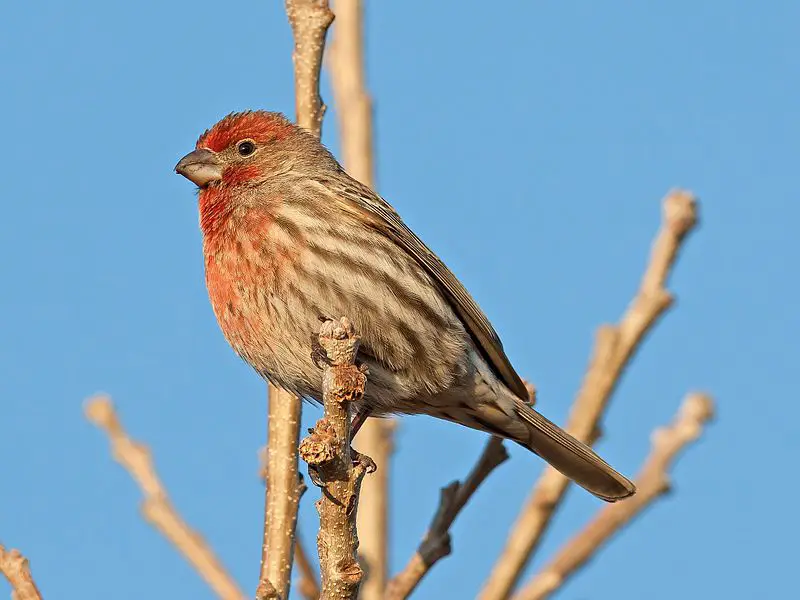
The house finch is a type of bird that belongs to the finch family called Fringillidae. This bird is originally from western North America.
However, it has also been introduced to other parts of the continent, such as the eastern half, as well as Hawaii. The house finch is not the only bird in its genus.
It is grouped with two other American rosefinches, and all three are placed in the genus Haemorhous. The house finch is known for its beautiful red coloration, especially in males. The males have a reddish hue on their heads, chests, and backs.
Females, on the other hand, have more muted colors with brownish feathers. These birds are relatively small, measuring about 12 to 16 centimeters in length. They have short wings and a slightly notched tail.
Their beaks are conical in shape and designed for cracking open see their primary food source. House finches are highly adaptable and can be found in various habitats, including urban areas, forests, and grasslands.
They are known for their melodious songs, which melodically communicate and attract mates. Breeding season for these.
| Kingdom | Animalia |
| Phylum | Chordata |
| Clade | Dinosauria |
| Class | Aves |
| Order | Passeriformes |
| Family | Fringillidae |
| Genus | Haemorhous |
| Species | H. mexicanus |
3. American Goldfinch
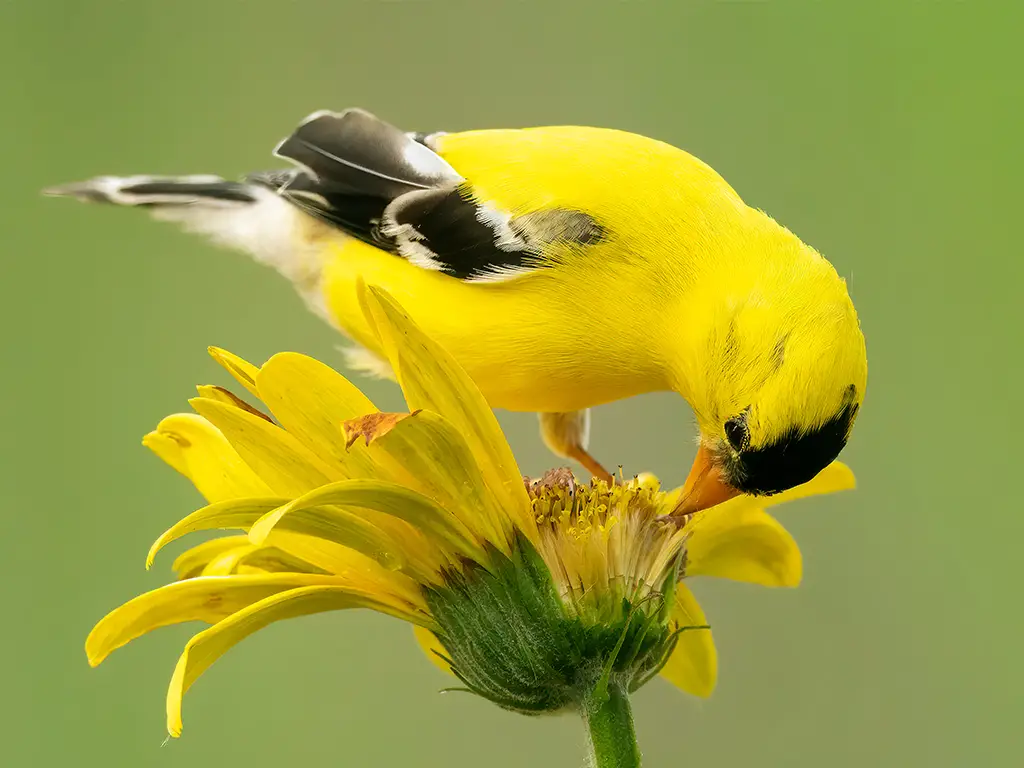
The American goldfinch is a type of bird that is found in North America.
It belongs to the finch family, which is a group of small birds known for their colorful feathers and pleasant songs. This bird is migratory, meaning it travels from one place to another depending on the time of year.
During the breeding season, which is when they mate and lay eggs, the American goldfinch can be found in an area ranging from mid-Alberta in Canada to North Carolina in the United States. In the winter, when the weather gets colder, the American goldfinch migrates to a different region.
They move from just south of the Canada–United States border and travel down to Mexico.
This helps them find better conditions for survival, as the temperature and food availability change with the seasons. The reason for their migration is mainly related to the availability of food.
During the breeding season, the American goldfinch feeds on insects and seeds from plants like sunflowers and thistles.
These food sources are abundant in the areas where they breed, providing them with the necessary nutrients for reproduction and raising their young. However, during the winter, these insects and plants may not be readily available in their breeding grounds.
| Kingdom | Animalia |
| Phylum | Chordata |
| Clade | Dinosauria |
| Class | Aves |
| Order | Passeriformes |
| Family | Fringillidae |
| Genus | Spinus |
| Species | S. tristis |
4. Red-Bellied Woodpecker
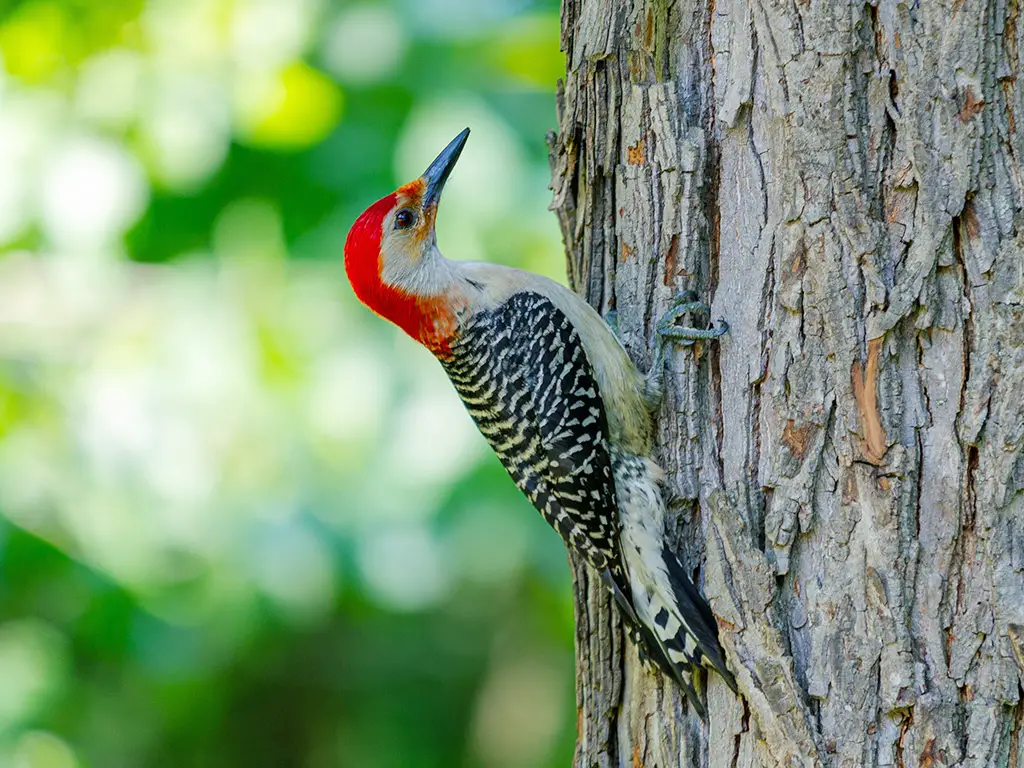
The red-bellied woodpecker is a type of bird that belongs to the family Picidae. It is not too big or too small; it is considered to be a medium-sized woodpecker.
This means that it is smaller than some other woodpecker species bmore significantger than others. These woodpeckers are found primarily in the eastern part of the United States. However, they can also be seen in other areas.
They have a wide range, stretching from as far south as Florida to as far north as Canada. This means that they can be found in many different states and provinces within these regions. When it comes to their appearance, the red-bellied woodpecker has some distinct features.
As the name suggests, they have a red belly, although this may not be immediately noticeable. Their belly is more of a pale or dull red color, compared to other parts of their body.
They also have a red cap on the top of their head, which is more vibrant and noticeable. In addition to their red belly and cap, these woodpeckers have a black and white pattern on their back, wings, and tail.
The black feathers provide a nice contrast against the white feathers, creating a visual.
| Kingdom | Animalia |
| Phylum | Chordata |
| Clade | Dinosauria |
| Class | Aves |
| Order | Piciformes |
| Family | Picidae |
| Genus | Melanerpes |
| Species | M. carolinus |
5. Northern Cardinal
The northern cardinal is a type of bird that is commonly referred to by different names such as redbird, common cardinal, red cardinal, or simply cardinal.
It belongs to the genus Cardinalis. The cardinal is primarily found in North America, particularly in regions such as the United States, Canada, and Mexico. It is known for its vibrant red plumage, which is more prominent in males than females.
The male cardinal has a distinctive crest on its head, while the female has a reddish tinge on its feathers. These birds are often observed in various habitats, including woodlands, gardens, and urban areas.
They are adaptable to different environments and can thrive in both rural and suburban settings.
Cardinals are also known for their beautiful songs, which are melodic and often used for communication and territorial marking. In terms of diet, the cardinal is omnivorous, meaning it eats various foods.
Its diet consists of seeds, fruits, insects, and occasionally small reptiles or amphibians.
They have a strong beak that allows them to crack open seeds and fruits with ease. During the breeding season, which typically occurs in spring and early summer, cardinals engage in courtship rituals. The male cardinal displays its vibrant red plum.
| Kingdom | Animalia |
| Phylum | Chordata |
| Clade | Dinosauria |
| Class | Aves |
| Order | Passeriformes |
| Family | Cardinalidae |
| Genus | Cardinalis |
| Species | C. cardinalis |
6. Eastern Towhee
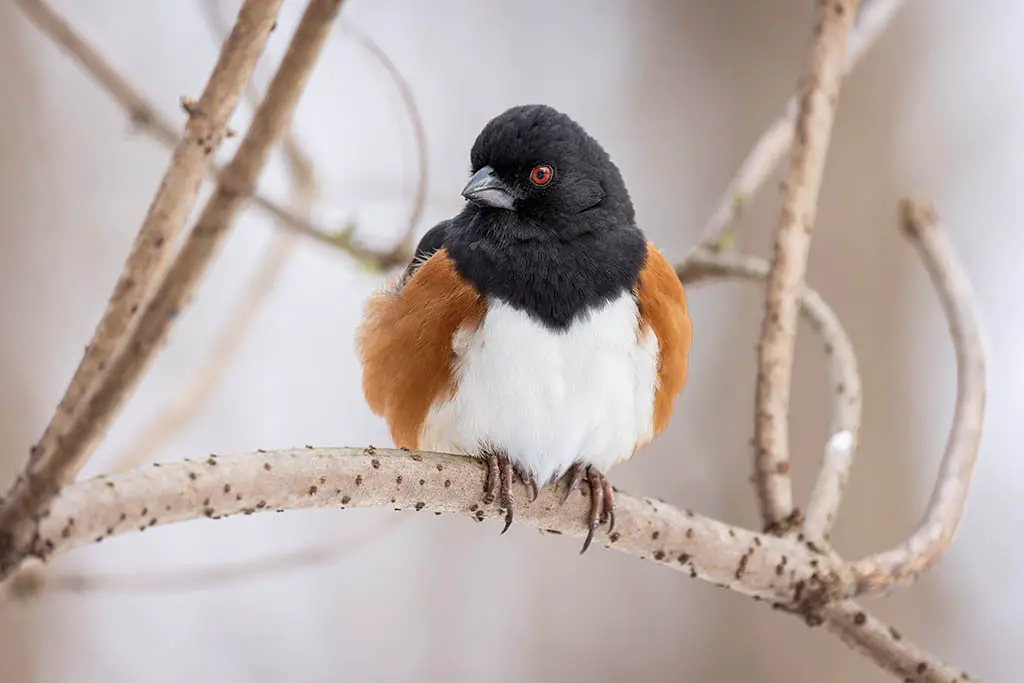
The eastern towhee is a type of sparrow that is found in the New World. It is a relatively large sparrow compared to other species. However, there has been some disagreement among scientists about the classification of towhees in recent years.
In the past, the eastern towhee and the spotted towhee were thought to be the same species called the rufous-sided towhee. The debate about the taxonomy of towhees has caused confusion and uncertainty among experts.
They have been trying to determine the exact relationship between the eastern towhee and the spotted towhee.
This has led to discussions and research to better understand the differences and similarities between these two birds. Despite the taxonomic debate, it is agreed that the eastern towhee has a specific breeding habitat in brushy areas across eastern North America.
This means that they prefer to build their nests and raise their young in areas that are filled with dense vegetation and shrubs. The brushy areas provide the eastern towhees with the necessary cover and protection for their breeding activities.
These habitats are abundant in eastern North America, making it an ideal place for the eastern towhee to thrive and Reprod studying the breeding habitats of the eastern towhee.
| Kingdom | Animalia |
| Phylum | Chordata |
| Clade | Dinosauria |
| Class | Aves |
| Order | Passeriformes |
| Family | Passerellidae |
| Genus | Pipilo |
| Species | P. erythrophthalmus |
7. Eastern Bluebird
The eastern bluebird is a type of bird that is native to North America. It is known for its ability to migrate, or travel, from one place to another.
It prefers to live in open woodlands, farmlands, and orchards where there are plenty of trees and open spaces. One notable feature of the eastern bluebird is its bright blue breeding plumage.
The male bluebird has this vibrant blue color on its feathers during the breeding season. This makes it easy to spot and observe when it is perched on a wire or in an open area.
Many birdwatchers, also known as birders, find the eastern bluebird to be a favorite species to observe because of its striking appearance. The blue color of the male bluebird’s feathers is often associated with the breeding season.
It is a way for the male to attract a mate and signal its readiness to reproduce.
The bright plumage acts as a visual cue for potential mates, indicating that the male is healthy and capable of producing offspring. In addition to its blue feathers, the eastern bluebird has other distinctive physical characteristics.
It has a small size compared to other birds, which allows it to maneuver easily in its woodland and farmland habitats.
| Kingdom | Animalia |
| Phylum | Chordata |
| Clade | Dinosauria |
| Class | Aves |
| Order | Passeriformes |
| Family | Turdidae |
| Genus | Sialia |
| Species | S. sialis |
8. Mourning Dove
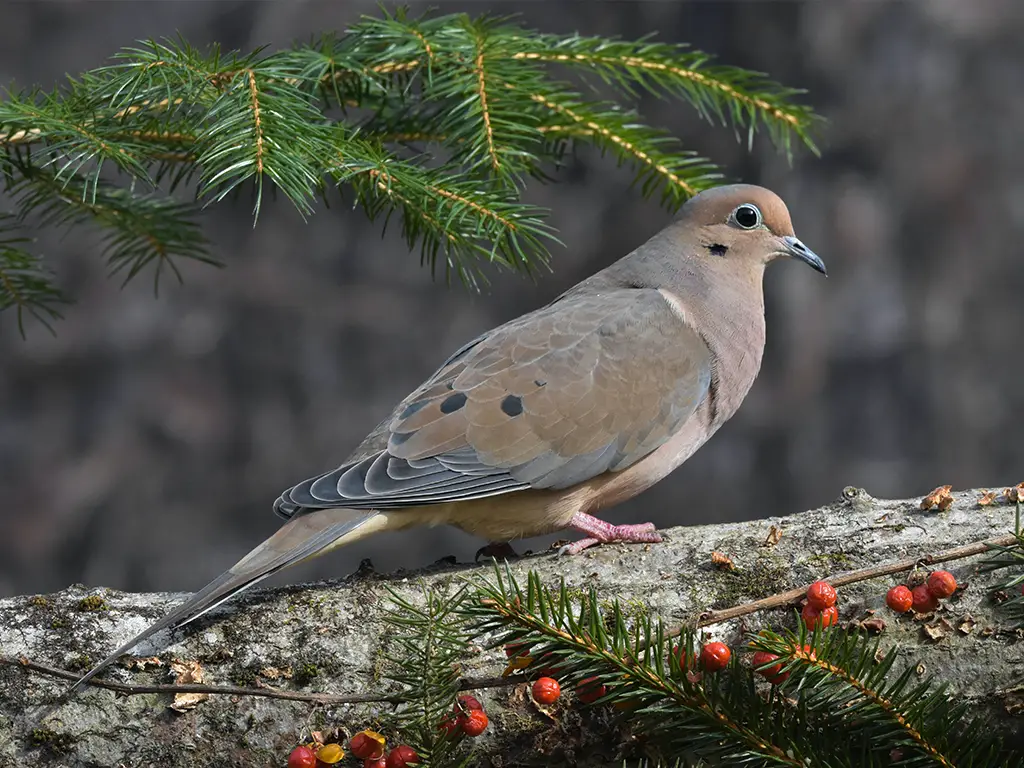
The mourning dove is a type of bird that belongs to the dove family called Columbidae. This bird is also known by different names such as the American mourning dove, the rain dove, colloquially as the turtle dove.
In the past, it was referred to as the Carolina pigeon and Carolina turtledove. The mourning dove is a common species found in North and Central America. It is recognized for its soft, mournful cooing sound, which gives it its name.
This bird is known for its slender body and long, pointed tail. It has a grayish-brown color with lighter shades on its underparts. One interesting fact about mourning doves is their ability to adapt to various habitats.
They can be found in different environments like forests, fields, urban areas, and even deserts. They are known to thrive in both rural and suburban settings. Mourning doves primarily feed on seeds, grains, and fruits.
They have a unique diet as they can swallow seeds whole and store them in their crop, a specialized part of their digestive system. This allows them to eat in one location and then retreat to a safer place to digest their food. These birds are monogamous, meaning they mate.
| Kingdom | Animalia |
| Phylum | Chordata |
| Clade | Dinosauria |
| Class | Aves |
| Order | Columbiformes |
| Family | Columbidae |
| Genus | Zenaida |
| Species | Z. macroura |
9. Carolina Chickadee
The Carolina chickadee is a type of bird that belongs to the passerine bird family, known as Paridae. It is a small bird that is often seen in North America.
The passerine bird family includes other birds like tits, which are known for their small size and agile nature. Carolina chickadees are known for their distinct appearance and behavior. They have a round body shape with a short neck and a small beak.
Their feathers are primarily gray on the upper parts and white on the underparts, with black and white markings on their wings and tails.
This coloration helps them blend in with their surroundings and provides camouflage for protection. These birds are often found in deciduous and mixed forests, as well as residential areas with trees and shrubs.
They prefer habitats with a variety of vegetation, including both coniferous and deciduous trees.
They also visit bird feeders in people’s yards, especially during months when food is scarce. Carolina chickadees are social birds and are often seen in small flocks.
They communicate with each other through a variety of vocalizations, including their well-known “chick-a-dee-dee-dee” call.
| Kingdom | Animalia |
| Phylum | Chordata |
| Clade | Dinosauria |
| Class | Aves |
| Order | Passeriformes |
| Family | Paridae |
| Genus | Poecile |
| Species | P. carolinensis |
10. Blue Jay
The blue jay is a type of bird that belongs to the family Corvidae. It can be found in eastern North America. This bird is commonly found in many parts of the eastern and central United States.
However, it is essential to note that some blue jays in the eastern regions may migrate to other areas. In addition to the United States, blue jays also reside in Newfoundland, Canada. They are considered residents in this area.
Breeding populations of blue jays can be observed across southern Canada. This means that these birds reproduce and raise their young in this region. Overall, the blue jay is a passerine bird, meaning it has specialized feet that allow it to perch on tree branches.
It is native to eastern North America and can be found in various parts of the United States, Newfoundland, and southern Canada.
| Kingdom | Animalia |
| Phylum | Chordata |
| Clade | Dinosauria |
| Class | Aves |
| Order | Passeriformes |
| Family | Corvidae |
| Genus | Cyanocitta |
| Species | C. cristata |
11. Palm Warbler
The palm warbler is a type of bird that belongs to the New World warbler family. This family includes various species of small songbirds. The palm warbler is one of them. These birds are relatively small in size and are known for their beautiful songs.
They have a distinct appearance, often characterized by their vibrant colors and patterns on their feathers. The palm warbler is commonly found in North America during the breeding season.
They migrate to their breeding grounds in the northern parts of Canada and Alaska during spring and summer.
In the winter, they migrate southward to the southern United States, the Caribbean, and Central America. One interesting fact about the palm warbler is its unique behavior of wagging its tail up and down while foraging on the ground.
This distinctive tail-wagging movement helps them catch their prey, which mainly consists of insects and spiders. These birds prefer habitats with dense vegetation, such as wetlands, marshes, and forests.
They build their nests on the ground, usually concealed under low shrubs or grasses. Their nests are carefully constructed using twigs, grass, and other plant materials. During the breeding season, male palm warblers display courtship behavior by singing to attract a mate.
| Kingdom | Animalia |
| Phylum | Chordata |
| Clade | Dinosauria |
| Class | Aves |
| Order | Passeriformes |
| Family | Parulidae |
| Genus | Setophaga |
| Species | S. palmarum |
12. Tufted Titmouse
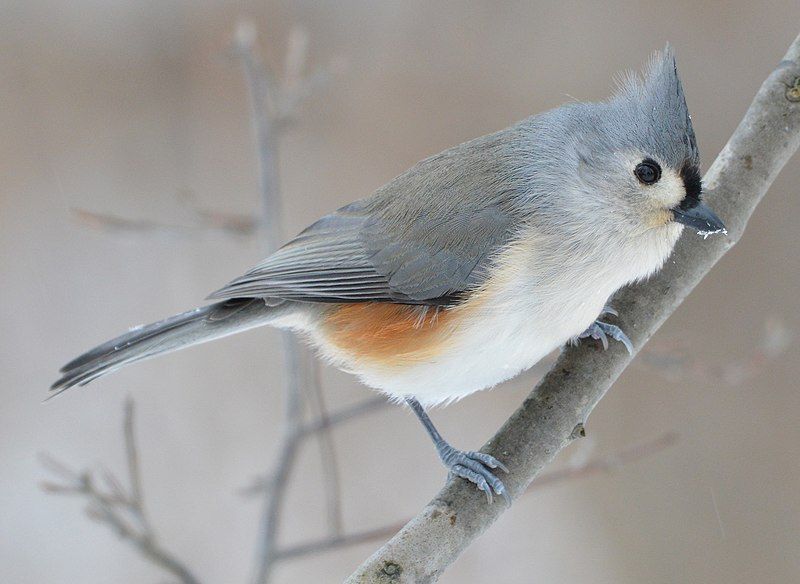
The tufted titmouse is a little bird that can be found in the North and belongs to the tit and chickadee family, which means it is closely related to other birds in that family.
In the past, there was another bird called the black-crested titmouse that was thought to be a subspecies of the tufted titmouse. This means they were similar in appearance and behavior but slightly different.
However, scientists have now determined that the black-crested titmouse is actually a separate species. It is officially called Baeolophus atricristatus. The black-crested titmouse is found in central and southern Texas, and it extends southward from there.
This means that it can be seen in areas further south from Texas as well. This separation of the black-crested titmouse from the tufted titmouse is essential in the scientific world.
It helps us understand the diversity of bird species and how they are related to each other. It is fascinating to learn about these small songbirds and the distinctions between different species.
By studying and understanding these differences, scientists can gain valuable insights into the natural world and the incredible.
| Kingdom | Animalia |
| Phylum | Chordata |
| Clade | Dinosauria |
| Class | Aves |
| Order | Passeriformes |
| Family | Paridae |
| Genus | Baeolophus |
| Species | B. bicolor |
13. Yellow-Rumped Warbler
The yellow-rumped warbler is a type of bird that is found in North Amt prettyite common and can be seen in many different places across the continent. This bird species is known for its distinct yellow feathers on its rump, or lower back.
This is where it gets its name from. These yellow feathers make it easy to identify the yellow-rumped warbler in the wild. The yellow-rumped warbler is a small bird, measuring around 5 to 6 inches in length. It has a slim body with a pointed beak and long wings.
Its wingspan can reach up to 9 to 10 inches, allowing it to fly swiftly and gracefully. One interesting fact about this bird is that it is known for its ability to migrate long distances. During the breeding season, yellow-rumped warblers can be found in North America.
However, when winter arrives, they migrate south to warmer regions, such as Mexico and Central America. This bird species can be found in a variety of habitats. It is often seen in forests, woodlands, and even urban areas.
It has adapted well to different environments and can thrive in both deciduous and coniferous forests. The yellow-rumped warbler has a diverse.
| Kingdom | Animalia |
| Phylum | Chordata |
| Clade | Dinosauria |
| Class | Aves |
| Order | Passeriformes |
| Family | Parulidae |
| Genus | Setophaga |
| Species | S. coronata |
14. White-Throated Sparrow
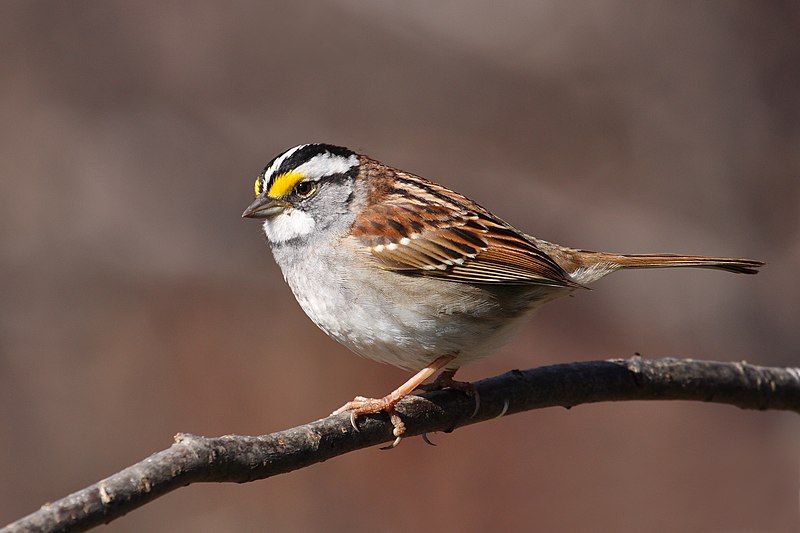
The white-throated sparrow is a type of bird that belongs to the passerine family called Passerellidae. This family of birds is commonly known as New World sparrows. Passerines are a diverse group of birds that make up more than half of all bird species.
They are known for their unique ability to perch and grip onto branches with their feet. The white-throated sparrow easily has a white patch on its throat. This feature gives the bird its name.
These sparrows are native to North America and can be found throughout the continent, from Canada to Mexico. They are migratory birds, meaning they travel long distances during certain times of the year.
During the breeding season, white-throated sparrows are known for their distinct song, which can be described as a whistling “Oh sweet Canada, Canada, Canada.” This song helps them attract mates and establish their territory.
White-throated sparrows are relatively small birds, measuring about 6 to 7 inches in length. They have a plump body with a rounded head and a short tail. Their plumage consists of a combination of gray, brown, and black feathers.
| Kingdom | Animalia |
| Phylum | Chordata |
| Clade | Dinosauria |
| Class | Aves |
| Order | Passeriformes |
| Family | Passerellidae |
| Genus | Zonotrichia |
| Species | Z. albicollis |
15. Carolina Wren
The Carolina wren is a type of wren bird that can be found in several regions. It is considered a common species, meaning it is frequently seen in these areas. The bird is mainly found in the eastern half of the United States of America.
This includes states like North Carolina, South Carolina, and Virginia. However, it can also be spotted in other states within this region. Apart from the United States, the Carolina wren is also seen in certain parts of Canada.
Specifically, it can be found in the extreme south of Ontario. This means that it is only present in the southernmost part of the province.
This is interesting because the bird’s range extends beyond the borders of the United States. Additionally, the Carolina wren can be observed in the extreme northeast of Mexico.
This means that it is found in the northeastern part of the country, close to the border it shares with the United States.
This further highlights the bird’s ability to inhabit different regions within North America. Overall, the Carolina wren is a resident bird in the eastern half of the United States, the extreme south of Ontario, Canada, and the extreme northeast of Mexico.
It is a common species, often seen in these areas. Its range includes several states.
| Kingdom | Animalia |
| Phylum | Chordata |
| Clade | Dinosauria |
| Class | Aves |
| Order | Passeriformes |
| Family | Troglodytidae |
| Genus | Thryothorus |
| Species | T. ludovicianus |
16. Wrens
Wrens are a type of bird that belongs to the family Troglodytidae. They are mainly found in the New World, which includes the Americas.
There are about 88 different species of wrens, and they are categorized into 19 different genera, which is a higher taxonomic rank. Interestingly, there is only one species of wren, called the Eurasian wren, that can be found in the Old World.
The Old World refers to regions such as Europe, Asia, and Africa. In English-speaking countries, this particular wren is commonly referred to as just “wren.”The reason behind this is that the Eurasian wren is believed to be the original wren species that gave rise to the name.
Over time, as people encountered different species of wrens in the New World, they started using more specific names to differentiate them.
However, the name “wren” stuck with the Eurasian species because it was the first one discovered and named. So, when people in Anglophone regions say “wren,” they are usually referring to the Eurasian wren.
It is essential to note that this is a regional naming convention and may not be accurate in other languages or parts of the world.
| Kingdom | Animalia |
| Phylum | Chordata |
| Clade | Dinosauria |
| Class | Aves |
| Order | Passeriformes |
| Family | Troglodytidae |
17. American Robin
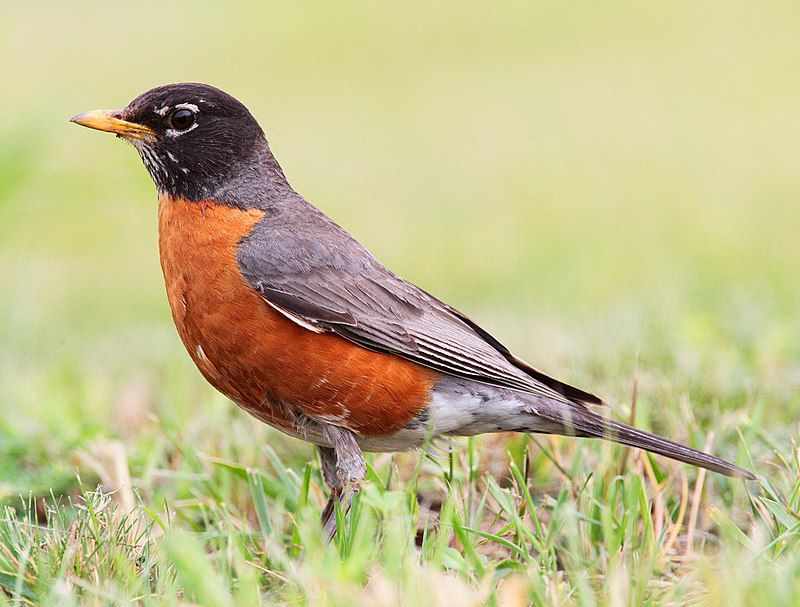
The American robin is a type of bird that migrates. It belongs to the validated thrush genus and the Turdidae family, which is more a prominent-ger family of thrushes. It gets its name from the European robin because of its reddish-orange breast.
However, it is essential to note that the American and European robin are not closely related. The European robin is a different species and belongs to the Old World flycatcher family.
Despite their similar names and physical characteristics, these two birds are not closely related in terms of their genetic makeup.
They may share some similarities in appearance, such as the reddish-orange breast, but their evolutionary paths have taken them in different directions. The American robin is primarily found in North America, while the European robin is native to Europe and parts of Asia.
Both species have adapted to their respective environments and habitats over time.
The American robin is known for its ability to migrate long distances, often traveling south during the winter months and returning north for breeding season. In terms of physical characteristics, the American robin is larger than the European robin.
It has a grayish-brown back and a distinct reddish-orange breast, which is a defining feature of the species.
| Kingdom | Animalia |
| Phylum | Chordata |
| Clade | Dinosauria |
| Class | Aves |
| Order | Passeriformes |
| Family | Turdidae |
| Genus | Turdus |
| Species | T. migratorius |
18. Northern Flicker
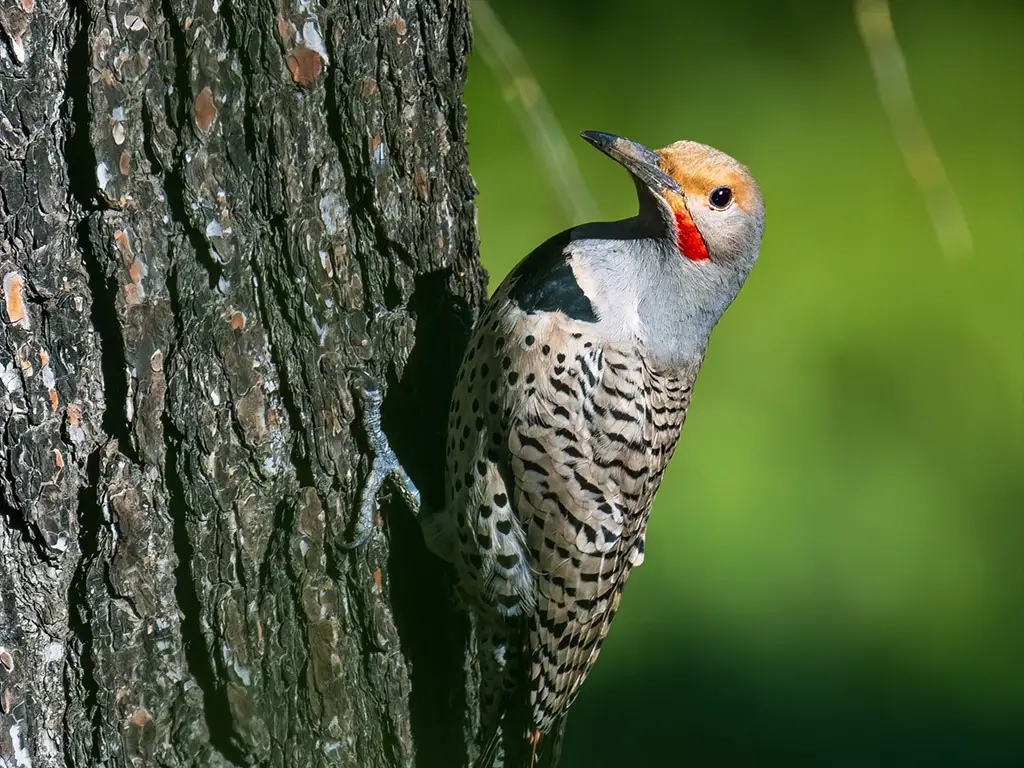
The northern flicker is a type of bird that belongs to the woodpecker family. It is not a very large bird, but it is also not too small. The northern flicker can be found in many parts of North America.
It is also native to some areas in Central America, such as Cuba and the Cayman Islands. The exciting thing about the northern flicker is that it is one of the few woodpecker species that migrate.
Migration means that these birds travel from one place to another during different seasons. They do this to find food and suitable habitats.
The northern flicker migrates to different regions depending on the time of year. During the breeding season, which is usually in the spring or summer, the northern flicker can be found in many parts of North America.
They build their nests in trees and use their strong beaks to create holes in the wood. These holes are called cavities and serve as their homes. Northern flickers are known for their distinctive markings.
They have brown bodies with black spots, and their wings are white pat-easily visible when flying. Another unique feature is the red or yellow coloration on the underside of their wings and tail, which can be seen when they.
| Kingdom | Animalia |
| Phylum | Chordata |
| Clade | Dinosauria |
| Class | Aves |
| Order | Piciformes |
| Family | Picidae |
| Genus | Colaptes |
| Species | C. auratus |
19. Northern Mockingbird
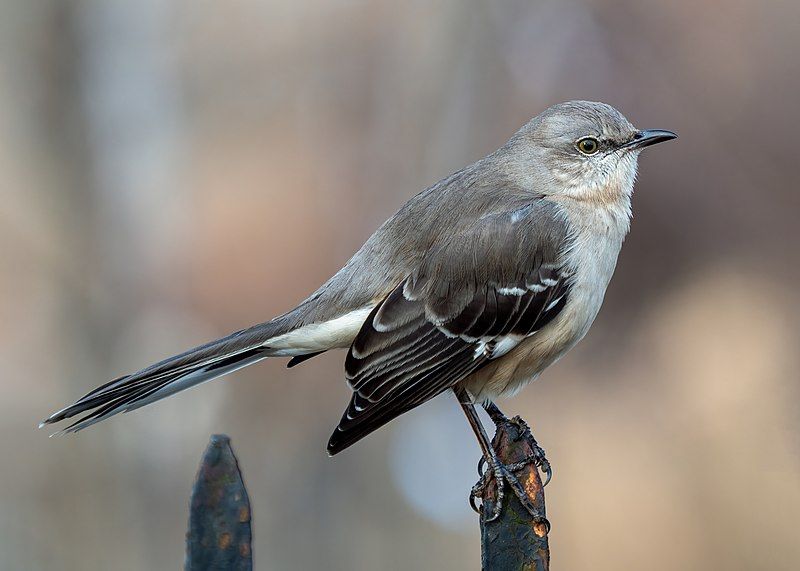
The northern mockingbird is a type of bird that is commonly found in North America. It is known for its ability to mimic the songs of other birds and even sounds from its environment.
This bird is typically seen throughout the year in North America, as it is a permanent resident in the region. However, during periods of extreme weather, such as harsh winters, some northern mockingbirds may decide to migrate south in search of more favorable conditions.
This shared migration only occurs when the weather becomes too challenging for these birds to handle. Despite being primarily found in North America, the northern mockingbird has been occasionally observed in Europe.
However, such sightings are rare, and this species is not considered a regular visitor to the European continent. It is interesting to note the adaptability of the northern mockingbird in terms of its ability to survive in different environments.
While it is mainly found in North America, it has the capacity to move to more suitable locations during times of adversity. The northern mockingbird’s ability to mimic sounds is a unique characteristic that sets it apart from other bird species.
This skill allows it to imitate the songs of various bi and sounds like car alarms, sirens, or even human speech.
| Kingdom | Animalia |
| Phylum | Chordata |
| Clade | Dinosauria |
| Class | Aves |
| Order | Passeriformes |
| Family | Mimidae |
| Genus | Mimus |
| Species | M. polyglottos |
20. Pine Warbler
The pine warbler is a type of bird. It belongs to the New World warbler family. This family includes various species of small songbirds. The pine warbler is one of them.
It is known for its beautiful songs and melodies. Being a small bird, the pine warbler is not very large in size. It is splendid and can measure around 5 to 6 inches in length.
Its small size allows it to move swiftly through the trees and vegetation. The pine warbler is primarily found in North America. It is commonly seen in the eastern parts of the United States and Canada, particularly in areas with pine forests.
These birds prefer to inhabit the coniferous forests, where they can find suitable nesting places and sources of food. As their name suggests, pine warblers have a particular affinity for pine trees. They are well adapted to living in these environments.
The birds have developedspecificcharacteristics that help them thrive in pine forests.
For example, their coloration allows them to blend in with the pine needles and branches, providing them with camouflage and protection from predators. One of the distinctive features of the pine warbler is its yellow plumage.
The males have a brighter yellow coloration, while the females are slightly.
| Kingdom | Animalia |
| Phylum | Chordata |
| Clade | Dinosauria |
| Class | Aves |
| Order | Passeriformes |
| Family | Parulidae |
| Genus | Setophaga |
| Species | S. pinus |
21. Great Egret
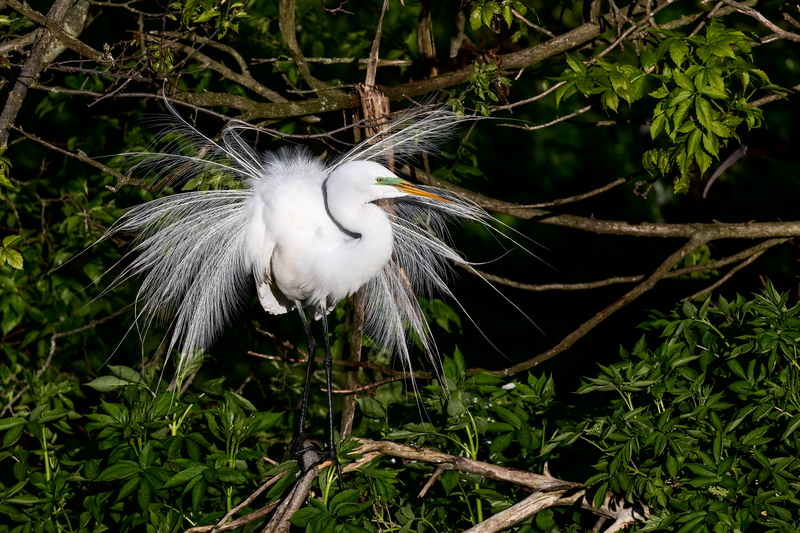
The great egret is a type of bird that is also commonly referred to as the common egret, large egret, great white egret, or great white heron. It is known for its large size and can be found in many different parts of the world.
There are four subspecies of the great egret, each of which is found in different regions. One subspecies of the great egret is found in Asia. These birds can be seen in various countries across the continent.
They are known for their elegant appearance and are often found near bodies of water, such as rivers, lakes, and ponds. Another subspecies of the great egret is found in Africa.
These birds can be spotted in different habitats throughout the continent, including wetlands, marshes, and coastal areas. They are skilled hunters and feed on fish, frogs, and other small aquatic creatures. The third subspecies of the great egret is found in the Americas.
This includes both North and South America. These birds can be found in a range of environments, such as swamps, estuaries, and even urban areas.
They are known for their graceful flight and striking white plumage. The final subspecies of the great egret is found in southern Europe.
| Kingdom | Animalia |
| Phylum | Chordata |
| Clade | Dinosauria |
| Class | Aves |
| Order | Pelecaniformes |
| Family | Ardeidae |
| Genus | Ardea |
| Species | A. alba |
22. Ruby-Throated Hummingbird
The ruby-throated hummingbird is a type of hummingbird that has a bright red throat. This species is known for its unique migration pattern, which occurs during the winter months in Central America, Mexico, and Florida.
They choose these areas during the winter months per regions because they provide a more suitable climate for their survival. However, when the summer season arrives, the ruby-throated hummingbird embarks on an incredible journey.
They migrate all the way to Canada and other parts of Eastern North America to breed.
This long-distance migration allows them to take advantage of the abundant resources available in these areas during the summer months. The reason behind this seasonal migration is quite fascinating.
In Central America, Mexico, and Florida, the ruby-throated hummingbirds find a variety of nectar-producing flowers that provide them with a sufficient food source.
These flowers bloom during the winter, ensuring the hummingbirds have enough energy to survive. But as the seasons shift and the temperatures rise, the flowers in these regions begin to wither away.
This scarcity of food prompts the hummingbirds to undertake their impressive journey northward. They instinctively know that Canada and Eastern North America offer an abundance of nectar-producing flowers during the summer, which is ideal for them.
| Kingdom | Animalia |
| Phylum | Chordata |
| Clade | Strisores |
| Class | Aves |
| Order | Apodiformes |
| Family | Trochilidae |
| Genus | Archilochus |
| Species | A. colubris |
23. Sanderling
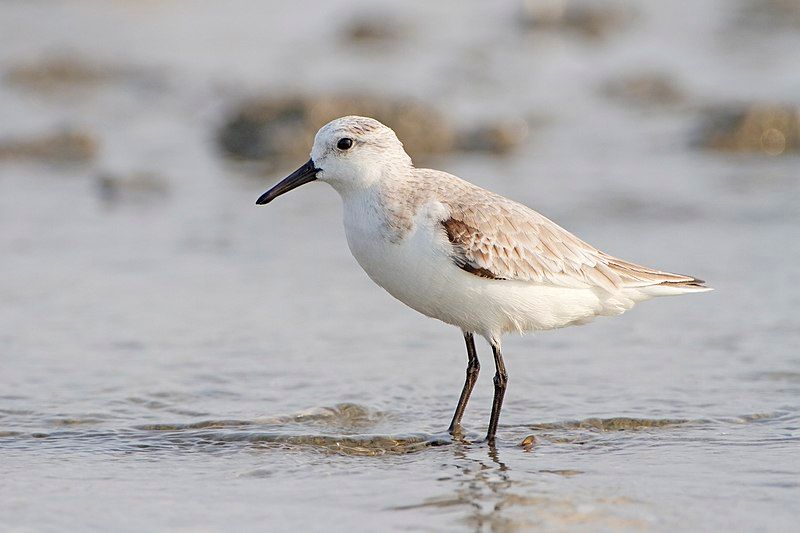
The sanderling is a type of bird that is known for being small and wading in water. It gets its name from the Old English word “sand-yrðling,” which means “sand-ploughman.” This name reflects its behavior of foraging or searching for food in the sand.
The name of the sanderling’s genus comes from the Ancient Greek words “kalidris” or “skalidris.” These terms were used by Aristotle, a famous philosopher and scientist, to describe certain birds that had a grey color and were often found near bodies of water.
In addition to the genus name, the sanderliso has a specific name. This particular name is “alba,” which comes from the Latin word for “white.” This name is fitting because the sanderling has predominantly white feathers, especially during the breeding season.
To summarize, the sanderling is a small wading biis known for its sand-ploughing behavior. Its nails are rooted in Old English and Ancient Greek, reflecting its characteristics and appearance. The specific name “alba” further emphasizes its white plumage.
| Kingdom | Animalia |
| Phylum | Chordata |
| Clade | Dinosauria |
| Class | Aves |
| Order | Charadriiformes |
| Family | Scolopacidae |
| Genus | Calidris |
| Species | C. alba |
24. Eastern Phoebe
The eastern phoebe is a small bird that belongs to the passerine family. This family includes birds that have feet specially adapted for perching, singing, and eating seeds or insects.
The eastern phoebe is one of these birds. The scientific name of the east phoebe is Sayornis. This name is derived from the specific part of Charles Lucien Bonaparte’s name for Say’s phoebe, another closely related bird species.
Charles Lucien Bonaparte was a French ornithologist who discovered and named several bird species. The specific name for Say’s phoebe, Muscicapa saya, was taken by Bonaparte and combined with the Ancient Greek word “ornis,” which means “bird.”
This combination resulted in the genus name Sayornis for the eastern phoebe. The genus name is essential in scientific classification because it helps scientists categorize and identify different species.
By using a standardized system of naming, scientists can communicate more effectively about specific birds and their characteristics. In this case, the genus name Sayornis indicates that the eastern phoebe is closely related to Say’s phoebe.
It helps scientists understand the evolutionary relationships between these two species.
| Kingdom | Animalia |
| Phylum | Chordata |
| Clade | Dinosauria |
| Class | Aves |
| Order | Passeriformes |
| Family | Tyrannidae |
| Genus | Sayornis |
| Species | S. phoebe |
25. Willet
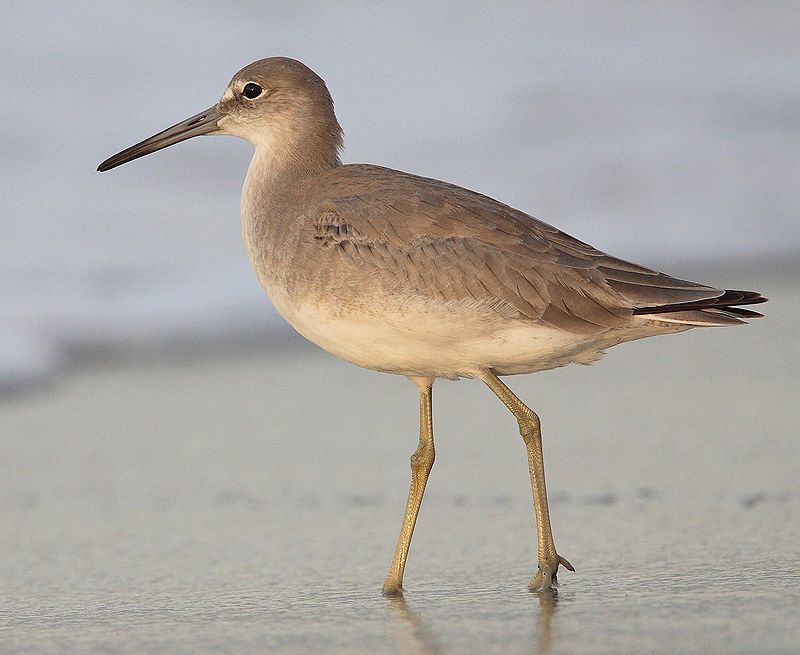
The willet is a type of bird that lives near the shore. It belongs to a family called Scolopacidae, which includes other birds like sandpipers.
The willet is a relatively big arobustong sandpiper, and it is actually the largest among a group of birds called “shanks” in the Tringa genus. Being a shorebird means that the willet is commonly found near bodies of water such as beaches, marshes, and estuaries.
It prefers habitats where it can find a mix of sandy and muddy areas. These areas are essential for the willet because they provide a good food source. The willet has a robust build, which means it has a strong and sturdy body.
This is different from other sandpipers that may be smaller and more delicate. Its size sets it apart from other members of the Tringa genus, making it the distinction of being the most enormous “shank.”A “shank” is a term. they are Used to describe a type of sandpiper bird.
It refers to a particular group of sandpipers within the Tringa genus. The willet is part of this group and happens to be the biggest among them. This makes the willet.
| Kingdom | Animalia |
| Phylum | Chordata |
| Clade | Dinosauria |
| Class | Aves |
| Order | Charadriiformes |
| Family | Scolopacidae |
| Genus | Tringa |
| Species | T. semipalmata |
26. Wood Duck
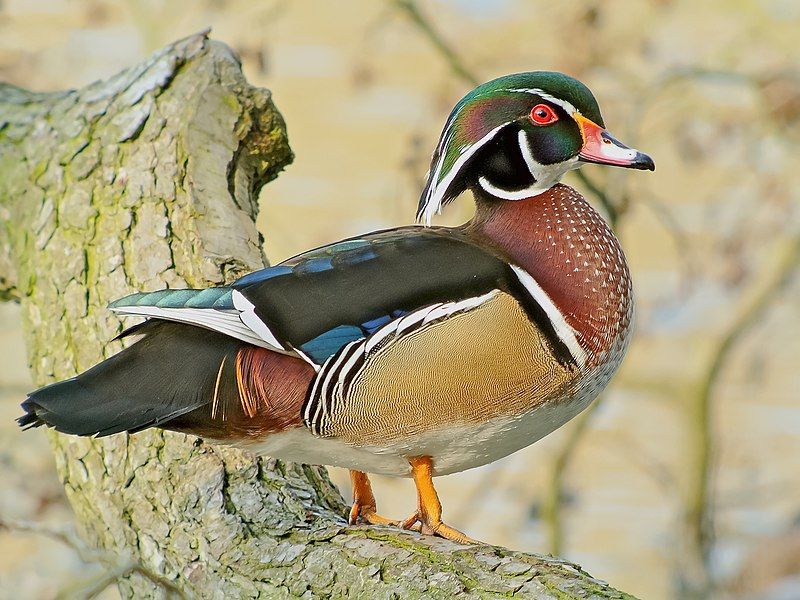
The wood duck, also known as the Carolina duck, is a type of perching duck that can be found in various parts of North America.
These ducks are known for their vibrant and beautiful colors, making them stand out among other waterfowls in the region. The male wood duck, known as a drake, is particularly stunning with its colorful plumage.
It has a combination of bright colors such as green, purple, white, and black. The drake’s head is adorned with a distinctive crest, which adds to its unique appearance. The colorful plumage of the drake wood duck serves various purposes.
One of the main reasons for their bright colors is to attract mates. The vibrant plumage helps the males attract female wood ducks during the breeding season.
The more colorful and vibrant a drake’s plumage, the more likely it is to catch the attention of a potential mate. Another reason for the wood duck’s colorful appearance is camouflage.
Although it may seem counterintuitive, the bright colors of the drake actually help it blend into its surroundings.
The intricate patterns and colors of its plumage mimic the dappled light and shadows found in wooded areas, making it harder for predators to spot them.
| Kingdom | Animalia |
| Phylum | Chordata |
| Clade | Dinosauria |
| Class | Aves |
| Order | Anseriformes |
| Family | Anatidae |
| Genus | Aix |
| Species | A. sponsa |
27. White-Breasted Nuthatch
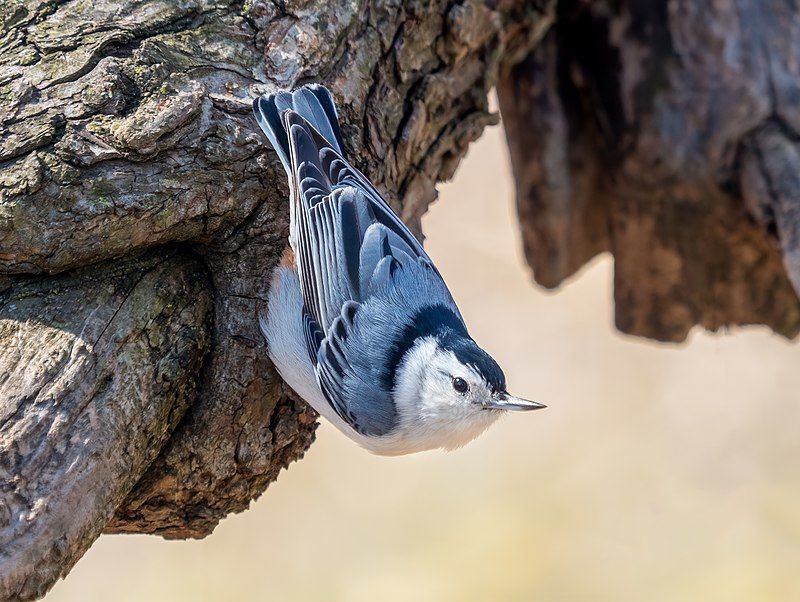
The white-breasted nuthatch is a type of bird that belongs to the nuthatch family called Sittidae.
This family includes various species of nuthatches, but we will focus on the white-breasted nuthatch in this discussion. The white-breasted nuthatch is considered to be a medium-sized bird, measuring around 15.5 cm in length.
This measurement gives us an idea of its size in comparison to other birds. While it may not be the most significant bird out there, it is also not the smallest. The exciting feature of the white-breasted nuthatch is its white breast, which gives it its name.
This white coloration on its chest stands out and helps to identify it from other species of nuthatches.
It is worth noting that not all nuthatches have this specific feature, making it unique to the white-breasted nuthatch. As a nuthatch family member, the white-breasted nuthatch shares particular characteristics with other nuthatch species.
For example, nuthatches are known for their ability to climb up and down trees headfirst. This behavior is quite fascinating to observe, as most birds can only move in an upward direction.
| Kingdom | Animalia |
| Phylum | Chordata |
| Clade | Dinosauria |
| Class | Aves |
| Order | Passeriformes |
| Family | Sittidae |
| Genus | Sitta |
| Species | S. carolinensis |
28. Red-Headed Woodpecker
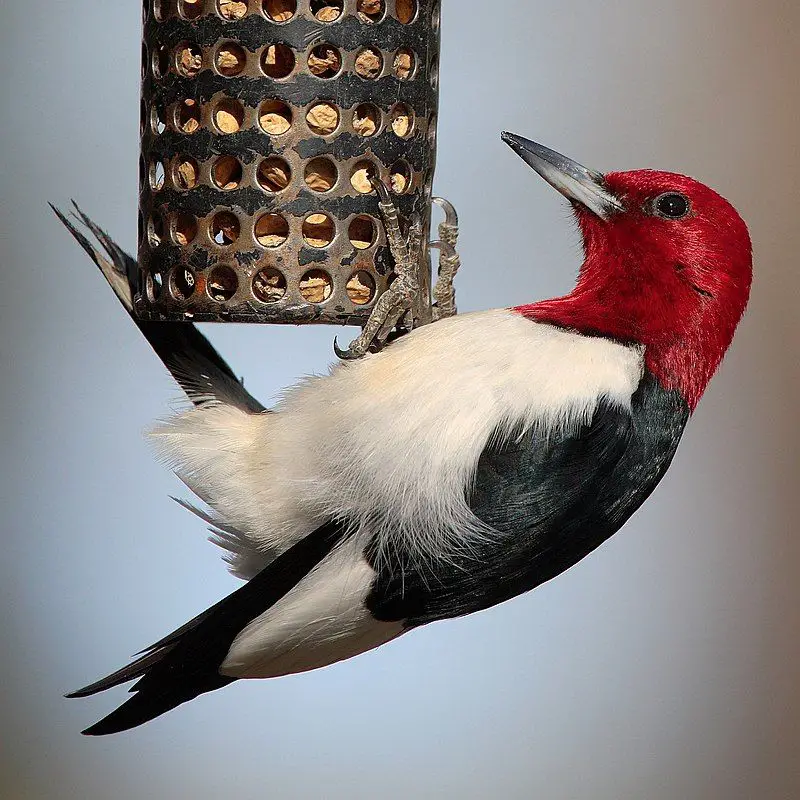
The red-headed woodpecker is a type of woodpecker that can be found in temperate regions of North America. It is not too big or too small, but rather a mid-sized bird. This woodpecker is known for its distinct red head, which sets it apart from other woodpecker species.
Its vibrant red color stands out against its habitat’s black and white biodegrading; the red-headed woodpecker prefers open areas in southern Canada and the east-central United States. It is specifically found in regions with a moderate climate.
During the breeding season, this woodpecker builds its in these open country habitats. It looks for suitable spots to create its nest, often choosing dead trees or branches.
The red-headed woodpecker is a skilled excavator, using its strong beak to make holes in the trees for its nests. These holes not only serve as a nesting site but also as a source of food storage.
In addition to nesting, the red-headed woodpecker also searches for food in its breeding habitat. It feeds various insects, fruits, nuts, and even small vertebrates. This woodpecker is known for its agility and acrobatics.
| Kingdom | Animalia |
| Phylum | Chordata |
| Clade | Dinosauria |
| Class | Aves |
| Order | Piciformes |
| Family | Picidae |
| Genus | Melanerpes |
| Species | M. erythrocephalus |
29. American Crow
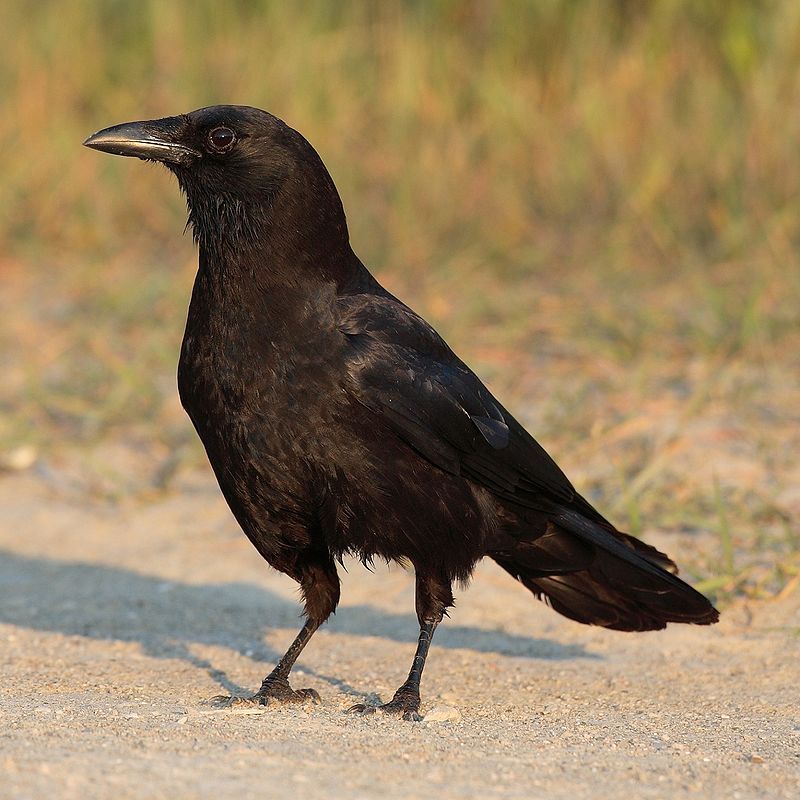
The American crow is a type of bird that belongs to the Corvidae family. This family includes other birds like ravens and jays. The American crow is quite extensive and is known as a passerine bird, meaning it has feet adapted for perching on branches.
You can find American crows in many parts of North America. They are a very common bird, so you might have seen them in your own neighborhood. They have adapted well to different environments and can be found in urban areas, forests, and even open fields.
Interestingly, American crows are similar to two other crows in different parts of the world. These are the carrion crow and the hooded care found in Europe and Asia.
Despite being from different continents, these three crows occupy the same ecological niche. An ecological niche refers to the role a species plays in its environment. In this case, the American crow, carrion crow, and hooded crow have similar behaviors and habits.
They are opportunistic feeders, meaning they eat a wide range of things like insects, fruits, small animals, and even garbage. They also play essential roles in controlling populations of certain pests ascavengingeng.
| Kingdom | Animalia |
| Phylum | Chordata |
| Clade | Dinosauria |
| Class | Aves |
| Order | Passeriformes |
| Family | Corvidae |
| Genus | Corvus |
| Species | C. brachyrhynchos |
30. Red-Winged Blackbird
The red-winged blackbird is a type of bird that belongs to the passerine family called Icteridae.
It is commonly found in various parts of North America and a significant portion of Central America. Passerines are a diverse group of birds that are known for their musical and complex songs.
They have specialized vocal organs that allow them to produce a wide range of sounds. The red-winged blackbird is easily recognizable due to its distinct appearance.
The male red-winged blackbird has glossy black plumage and bright red patches on its wings, which give it its name.
On the other hand, the female red-winged blackbird has a more subdued appearance with brown feathers and streaks. These birds have a unique habitat preference, as they are commonly found in wetlands, marshes, and areas with tall grasses.
They are skilled at perching on tall plants and reeds, where they can easily spot their prey and potential predators. Red-winged blackbirds primarily feed on insects, seeds, and grains. They use their sharp beaks to catch insects on the fly and extract seeds from plants.
During the breeding season, they may also consume small vertebrates such as frogs and tadpoles.
| Kingdom | Animalia |
| Phylum | Chordata |
| Clade | Dinosauria |
| Class | Aves |
| Order | Passeriformes |
| Family | Icteridae |
| Genus | Agelaius |
| Species | A. phoeniceus |
31. Common Grackle
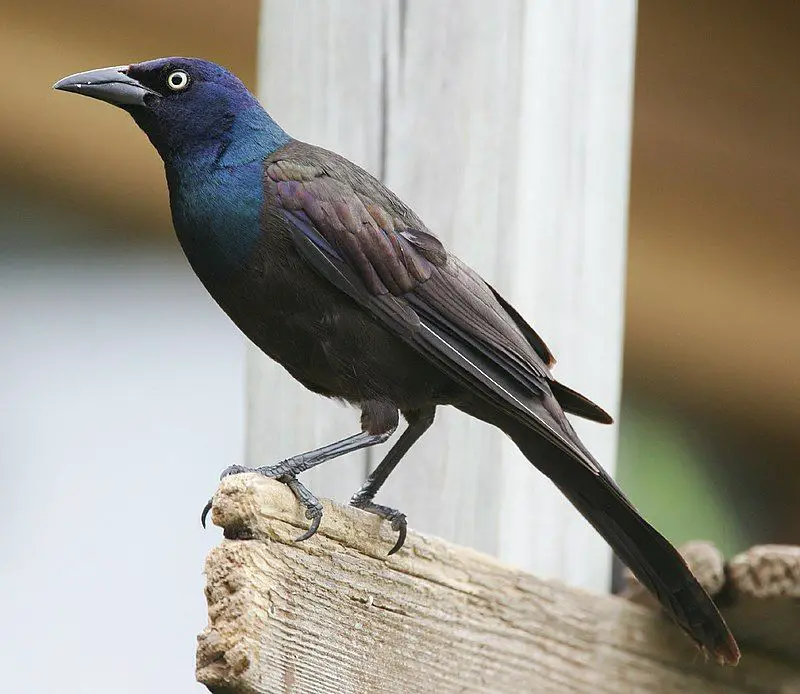
The common grackle is a type of bird that can be found in many parts of North America. It was first identified and described by a scientist named Carl Linnaeus in the year 1758. This bird belongs to a family of birds known as icterids.
One exciting thing about the common grackle is its three different subspecies. This means that there are slight variations in appearance among the various groups of these birds. When an adult common grackle is fully grown, it has certain distinct features.
For example, it has a long bill that is dark in color. This bill is used by the bird to catch and eat its food. The common grackle also has pale yellow eyes, which add to its unique appearance. Another noticeable characteristic of the adult common grackle is its long tail.
This tail is essential to the bird’s body, as it helps with balance and maneuverability during flight. It is worth noting that the common grackle is a reasonably large bird compared to some other species.
Its size contributes to its visibility and makes it easier to spot in its natural habitat. Overall, the common grackle is an exciting bird species with distinct physical traits. It’s large numbers across North.
| Kingdom | Animalia |
| Phylum | Chordata |
| Clade | Dinosauria |
| Class | Aves |
| Order | Passeriformes |
| Family | Icteridae |
| Genus | Quiscalus |
| Species | Q. quiscula |
32. Yellow-Bellied Sapsucker
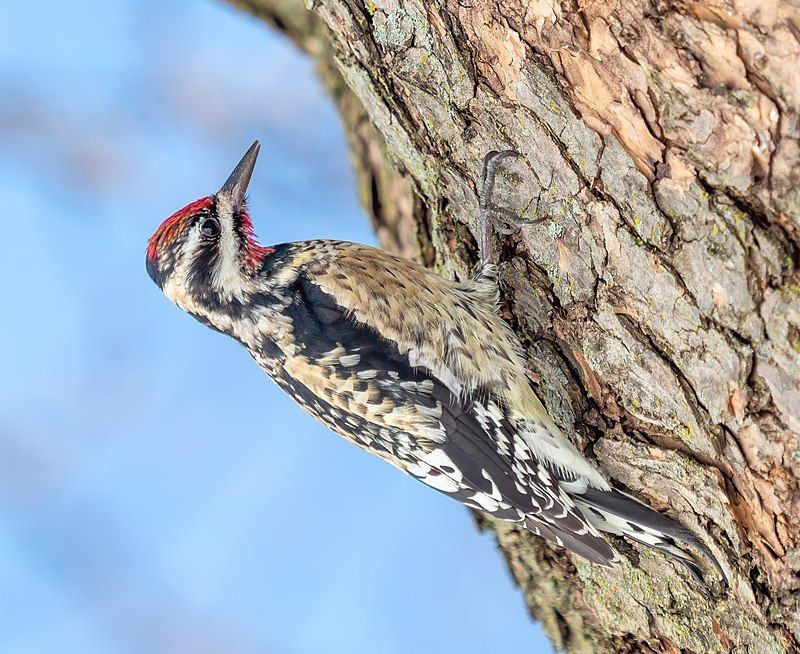
The yellow-bellied sapsucker is a type of bird that belongs to the woodpecker family. It is not too big or too small, but rather a medium-sized bird. This bird can be found in two specific regions, Canada and the northeastern part of the United States.
The yellow-bellied sapsucker is known for its distinct appearance. It has a yellow belly, which is where it gets its name from. This bright yellow color stands out against the bird’s black and white feathers. This woodpecker has a unique behavior when it comes to feeding.
It mainly relies on tree sap as its primary food source. It driltinyall holes in tree trunks using its strong beak and long tongue to extract the sap. This behavior of drilling holes is why it is called a sapsucker.
Apart from sap, this bird also feeds on insects, fruits, and berries. It has a diverse diet that includes insects like ants, beetles, and caterpillars. Additionally, it enjoys consuming fruits and berries when they are available.
Breeding is an essential aspect of the yellow-bellied sapsucker’s life cycle. It chooses to breed in two specific regions, Canada and the northeastern part.
| Kingdom | Animalia |
| Phylum | Chordata |
| Clade | Dinosauria |
| Class | Aves |
| Order | Piciformes |
| Family | Picidae |
| Genus | Sphyrapicus |
| Species | S. varius |
33. Hooded Warbler
The hooded warbler is a type of bird that belongs to the New World warbler family. It is found in eastern North America, specifically across the eastern United States and even in the southernmost parts of Canada.
These birds have a wide breeding range in this region. During the winter season, hooded warblers migrate to different areas. They travel all the way to Central America and the West Indies, where they spend the colder months.
This migration is a natural behavior for hooded warblers, allowing them to find more favorable conditions for survival during the winter. Despite their extensive breeding and wintering range, hooded warblers are considered to be rare vagrants in Western Europe.
This means that they are not commonly seen in this part of the world.
The occurrence of hooded warblers in Western Europe is infrequent and unusual, making it noteworthy for birdwatchers and ornithologists. Their distinctive feature is the hood-like black marking on the males’ heads, which gives them their name.
This black hood contrasts with their bright yellderparts, making them easily identifiable. The females, on the other hand, the females hood and are generally duller in color. Hooded warblers prefer forested.
| Kingdom | Animalia |
| Phylum | Chordata |
| Clade | Dinosauria |
| Class | Aves |
| Order | Passeriformes |
| Family | Parulidae |
| Genus | Setophaga |
| Species | S. citrina |
34. Cedar Waxwing
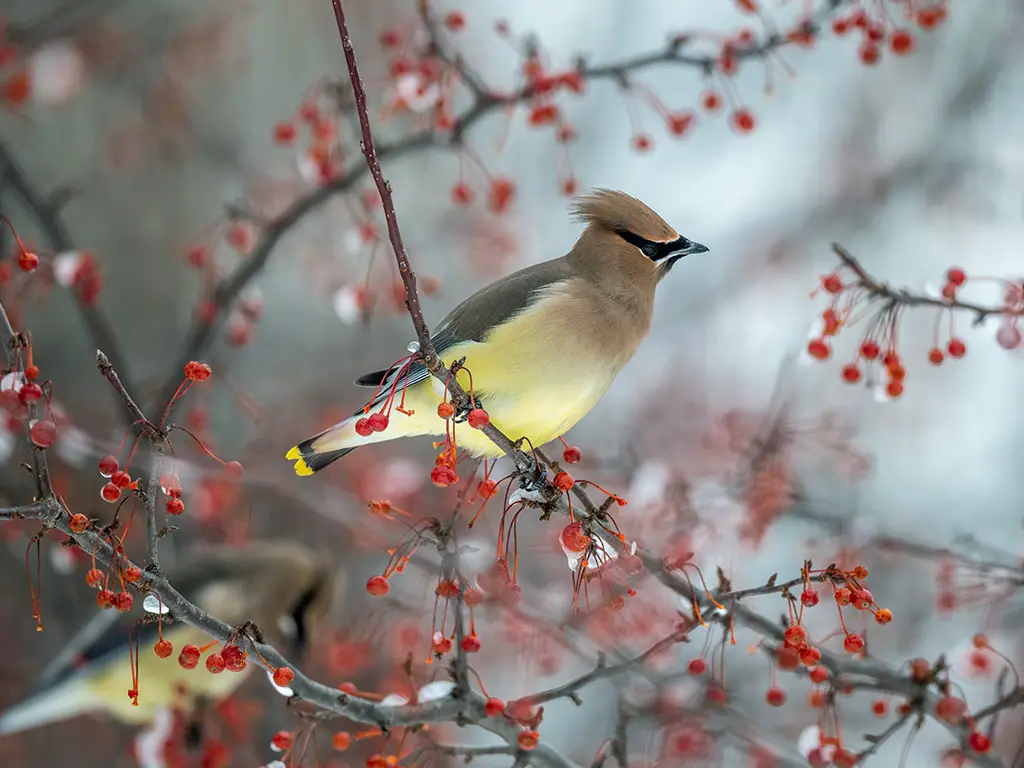
The cedar waxwing is a bird that belongs to the waxwing family of passerine birds known as Bombycillidae. Passerine birds are perching birds, which means they have feet adapted for gripping branches.
The cedar waxwing is a medium-sized bird with a distinctive appearance. Its feathers are mostly brown, gray, and yellow in color.
These colors help the bird blend well with its surroundings, making it harder for predators to spot it. One of the most unique features of the cedar waxwing is its wings. The bird gets its name from the wax-like tips on its wings.
These wing tips look as if they have been dipped in wax, giving the bird a fascinating and memorable look. The wax-like wing tips serve a purpose for the cedar waxwing. They are actually specialized feathers that help the bird in various ways.
The waxy substance on the wing tips repels water, allowing the bird to fly more easily in wet weather conditions. It also helps the bird glide smoothly through the air, reducing air resistance. Another exciting aspect of the cedar waxwing is its diet.
This bird primarily feeds on fruits, such as berries, and small fruits like cherries. It has a unique adaptation in it.
| Kingdom | Animalia |
| Phylum | Chordata |
| Clade | Dinosauria |
| Class | Aves |
| Order | Passeriformes |
| Family | Bombycillidae |
| Genus | Bombycilla |
| Species | B. cedrorum |
35. Brown-Headed Cowbird
The brown-headed cowbird is a bird species found in temperate and subtropical regions of North America. It is known for its behavior as a brood parasite, meaning it lays its eggs in the nests of other bird species.
This behavior is obligatory for the brown-headed cowbird, which means it relies on other birds to raise its young. Being a small bird, the brown-headed cowbird has a brown head and dark body.
It is commonly found in the southern parts of its range throughout the year, where it remains a permanent resident.
However, the birds from the northern regions migrate to the southern United States and Mexico during the winter season.
The migration of the northern brown-headed cowbirds occurs because the colder conditions in their northern habitats make it challenging to find sufficient food during the winter months.
By traveling to the southern regions, where the climate is milder and food resources are more abundant, they increase their chances of survival. The migration typically takes place in a southward direction, starting around the onset of winter.
These birds undertake a long journey, often flying for many miles to reach their wintering grounds. They remain in these warmer regions until the arrival of spring, which is around March or April, once the winter season ends.
| Kingdom | Animalia |
| Phylum | Chordata |
| Clade | Dinosauria |
| Class | Aves |
| Order | Passeriformes |
| Family | Icteridae |
| Genus | Molothrus |
| Species | M. ater |
36. Brown-Headed Nuthatch
The brown-headed nuthatch is a type of bird. It is known for its small size and can be found in pine forests. This bird is only found in the Southeastern part of the United States. The brown-headed nuthatch has a distinct feature – a brown head.
This feature makes it easy to identify this bird. The nuthatch is not a very large bird; it is relatively small in size. This species of bird is unique because it is only found in pine forests.
It prefers this type of habitat and can be seen fluttering around the trees in these forests. The brown-headed nuthatch is considered endemic to the Southeastern United States. This means that it is found exclusively in this region and is not found anywhere else in the world.
The nuthatch is also known for its song. It has a melodious chirp that can be heard in the pine forests it inhabits. This song is a way for the bird to communicate with other nuthatches and establish its territory.
The pine forests provide an ideal environment for the brown-headed nuthatch. These birds rely on the trees for nesting and foraging for food. They can often be seen climbing up and down the trunks.
| Kingdom | Animalia |
| Phylum | Chordata |
| Clade | Dinosauria |
| Class | Aves |
| Order | Passeriformes |
| Family | Sittidae |
| Genus | Sitta |
| Species | S. pusilla |
37. Barn Swallow
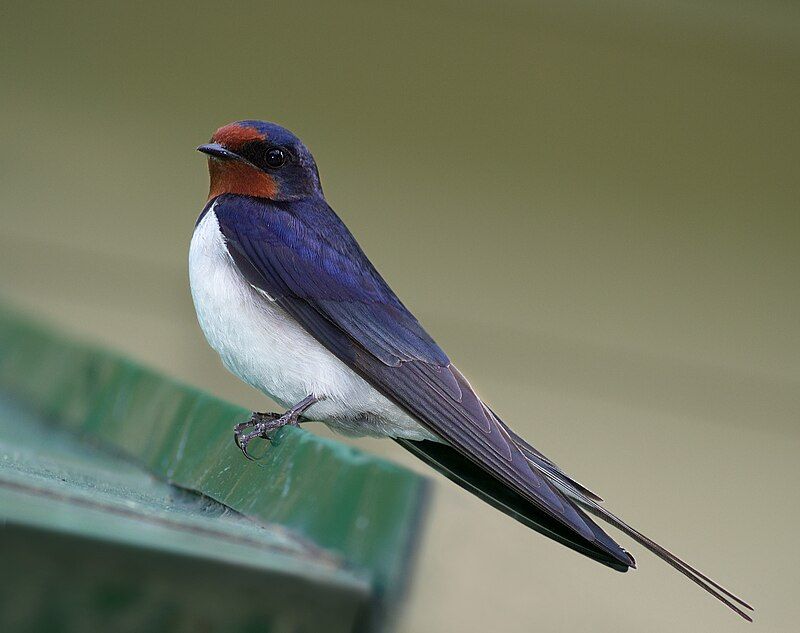
The barn swallow is a type of bird that can be found all over the world. It is actually the most common swallow.
This means that there are more barn swallows than any other type of swallow in the world. What is interesting about the barn swallow is that it can be found in many different places. It has the most extensive natural distribution of any passerine bird.
Passerine birds are a type of bird that includes sparrows, finches, and swallows. This means that the barn swallow can be found in more areas than any other type of passerine bird. In fact, the barn swallow’s range covers over 251 million square kilometers worldwide.
That is a vast area! To put it into perspective, that’s about the same size as the entire continent of Europe.
So, no matter where you go in the world, there is a good chance that you will spot a barn swallow. The barn swallow is easily recognizable due to its distinctive appearance. It has blue upperparts, which means that its back and wings are blue in color.
This blue color is quite vibrant and stands out against the sky. It also has a long, deeply forked tail. This means that its tail is split into two distinct points.
| Kingdom | Animalia |
| Phylum | Chordata |
| Clade | Dinosauria |
| Class | Aves |
| Order | Passeriformes |
| Family | Hirundinidae |
| Genus | Hirundo |
| Species | H. rustica |
38. Pileated Woodpecker
The pileated woodpecker is a type of bird that is primarily black and is found in North America. It is a relatively large bird compared to other woodpeckers. The pileated woodpecker mostly eats insects, which makes it an insectivore.
It usually lives in deciduous forests located in eastern North America. In addition to the east part of North America, the pileated woodpecker can also be found in the Great Lakes region. This means it can be seen in areas like Michigan, Minnesota, and the surrounding states.
The bird is also found in the boreal forests of Canada. These forests are characterized by primarily coniferous trees and are located in northern Canada. Furthermore, the pileated woodpecker can be spotted in certain areas along the Pacific Coast.
This means it can be found in states like Oregon and Washington. It is interesting to note that the bird’s habitat spans across different regions, showing its adaptability to various environments.
Overall, the pileated woodpecker is a fascinating bird that is native to North America. Its black feathers and relatively large size make it easy to identify. It prefers to live in deciduous forests.
| Kingdom | Animalia |
| Phylum | Chordata |
| Clade | Dinosauria |
| Class | Aves |
| Order | Piciformes |
| Family | Picidae |
| Genus | Dryocopus |
| Species | D. pileatus |
39. Swifts
The paragraph talks about swifts, which are a family of birds called Apodidae. These birds are known for their highly aerial abilities, meaning they are really good at flying.
Although they may look similar to swallows, they are not closely related to any species of passerine birds. Swifts belong to the order Apodiformes, which also includes hummingbirds. This means that swifts and hummingbirds share similarities in their order classification.
They both have specific characteristics or features that group them together. The term “superficially similar” means that at first glance, swifts may appear similar to swallows. They might have some physical resemblances or behaviors that make them look alike.
However, upon closer examination, it becomes clear that they are not closely related to swallows or any other passerine species. Passerine species refer to a specific group of birds that belong to the order Passeriformes.
These birds have specialized feet that allow them to perch or cling to branches. Swallows are part of this passerine group, while swifts are not. In summary, swifts are a family of birds known for their exceptional flying skills.
They may look similar to swallows, but they are not closely related.
| Kingdom | Animalia |
| Phylum | Chordata |
| Clade | Strisores |
| Class | Aves |
| Order | Apodiformes |
| Family | Apodidae |
40. New World Warblers
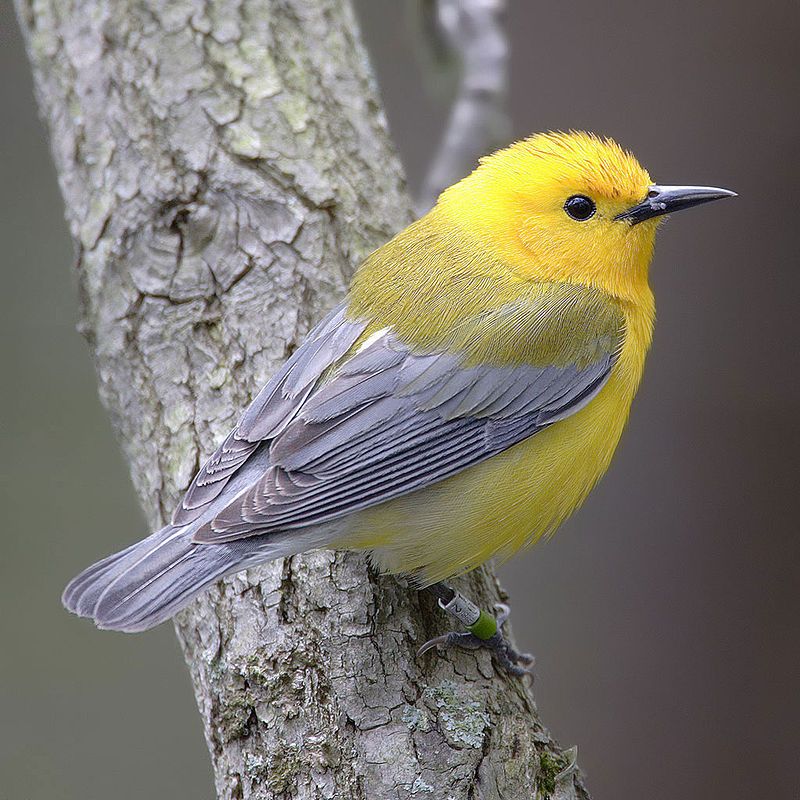
The New World warblers, also known as wood warblers, are small birds found in the Americas. These birds are often vibrant and eye-catching, with colorful plumage that stands out in their surroundings.
They belong to the family Parulidae, which is a group of passerine birds, meaning they have specialized feet for perching. New World warblers are only found in the Americas unlike other bird species. They are not seen in different parts of the world, such as Europe or Asia.
This geographical restriction sets them apart from Old World warblers, which are found in Europe, Asia, and Africa.
Similarly, they are not closely related to Australian warblers, which are native to Australia and nearby regions. The New Worsingersers have distinct characteristics and evolutionary history.
Although they may share some similarities in behavior or appearance with other warbler species, they have evolved separately and have distinct genetic lineages.
Their unique adaptation to the New World environment has shaped their physical traits and behaviors. One of the notable features of New World warblers is their colorful plumage. Many species exhibit vibrant yellow, blue, green, and hues, making them a delight to observe.
| Kingdom | Animalia |
| Phylum | Chordata |
| Clade | Dinosauria |
| Class | Aves |
| Order | Passeriformes |
| Family | Parulidae |
41. Sandhill Crane
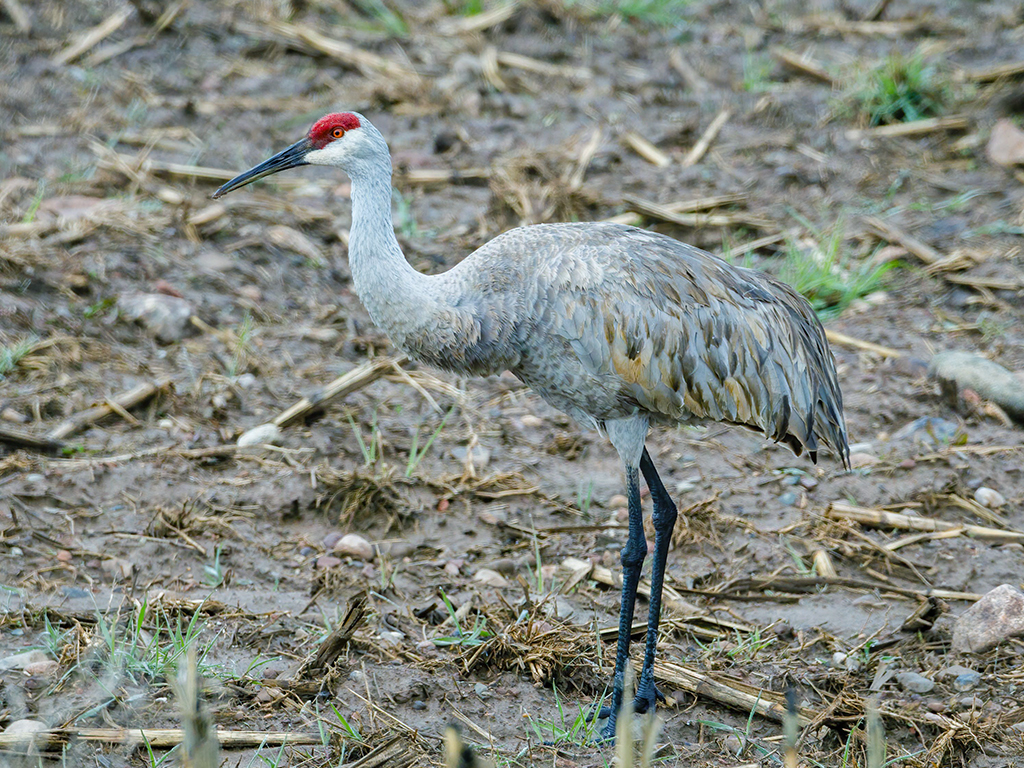
The sandhill crane is a type of bird. It is a large crane that can be found in N and extreme northeastern Siberia. Its common name comes from the habitat it prefers, which is similar to the Platte River. This river is located on the edge of Nebraska’s Sandhills.
The Sandhills are part of the American Great Plains. The sandhill crane is known for its distinctive appearance and behavior. It has long legs and a long neck, which allows it to stand tall and walk gracefully. The bird has a grayish-brown body, with patches of red on its head.
It also has long, pointed bees to catch and eat its food. These cranes are highly adapted to living in wetland areas. They can be found in marshes, bogs, and shallow lakes. The Platte River, for example, provides an ideal habitat for them.
The river’s sandbars, wetlands, and surrounding grasslands offer a perfect environment for the sandhill cranes to forage and rest. During their migration, sandhill cranes form large flocks that can number in the thousands.
They fly in a V-formalising of the air currents to conserve energy.
| Kingdom | Animalia |
| Phylum | Chordata |
| Clade | Dinosauria |
| Class | Aves |
| Order | Gruiformes |
| Family | Gruidae |
| Genus | Antigone |
| Species | A. canadensis |
42. Barred Owl
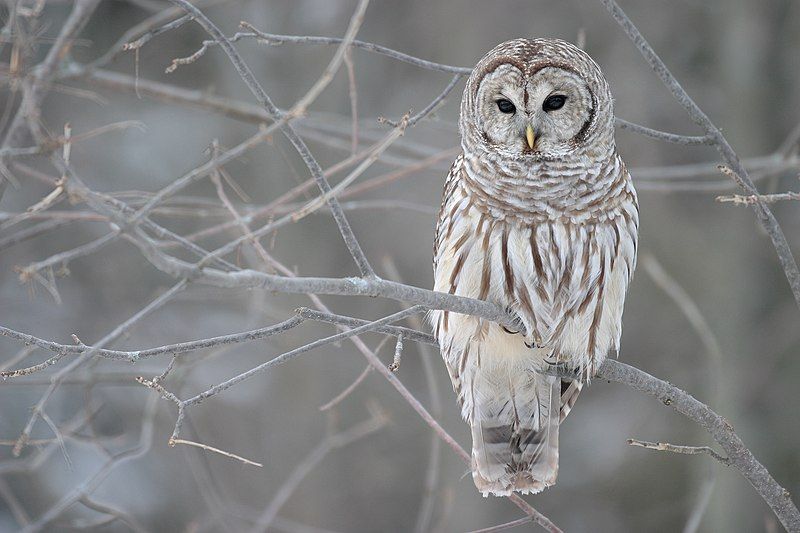
The barred owl is a type of object found in North America. It is sometimes called the northern barred owl, striped owl, hoot owl, or eight-hooter owl.
This owl is quite large compared to other owls. It belongs to a family of owls called Strigidare, known as true owls. The barred owl belongs explicitly to the genus Strix.
The name of the family, Strigidaly, comes from the genus Strix. Linnaean taxonomy is a system of naming and classifying organisms by Carl Linnaeus, a Swedish botanist and scientist.
This system organizes living organisms into different categories based on their characteristics. The barred owl’s scientific name is Strix The genus name comes from the Linnaean taxonomist, followed by the species name.
So, for the barred owl, Strix is the get,nus, and varia is the species.
This helps scientists and researchers identify and study different species. The barred owl is known for its distinctive call, which sounds like “who-cooks-for-you, who-cooks-for-you-all.” This call is often heard at night. It is sometimes called a hoot owl.
| Kingdom | Animalia |
| Phylum | Chordata |
| Clade | Dinosauria |
| Class | Aves |
| Order | Strigiformes |
| Family | Strigidae |
| Genus | Strix |
| Species | S. varia |
43. Red-Tailed Hawk
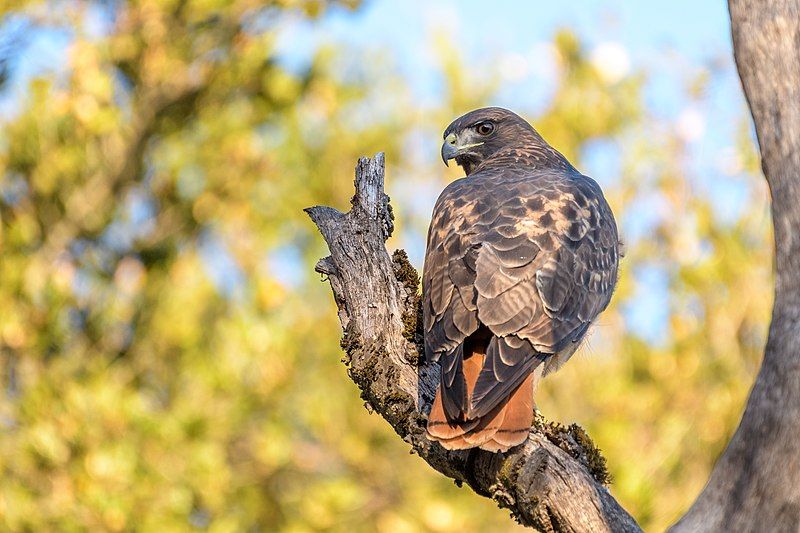
The red-tailed hawk is a type of bird known as a bird of prey. It is found in many different parts of North America. It breeds in various locations, from the interior of Alaska and northern Canada to Panama and the West Indies.
This means you can find red-tailed hawks in many places throughout North America. The red-tailed hawk belongs to a group of birds called the genus Buteo. This genus includes many other species of hawks.
However, the red-tailed hawk is one of the most common members of this group, both in North America and worldwide.
This means you will likely encounter a red-tailed hawk more often than other hawks within the Buteo genus. The red-tailed hawk is known for its distinctive red tail, which is where it gets its name from.
This feature helps to distinguish it from other types of hawks. However, it is essential to note that not all red-tailed hawks have red tails.
Juvenile red-tailed hawks have brown tails, which only turn red as they mature. Red-tailed hawks are known for their impressive hunting skills. As birds of prey, they primarily.
| Kingdom | Animalia |
| Phylum | Chordata |
| Clade | Dinosauria |
| Class | Aves |
| Order | Accipitriformes |
| Family | Accipitridae |
| Genus | Buteo |
| Species | B. jamaicensis |
44. Great Blue Heron
The great blue heron is a bird from the heron family called Ardeidae. It is a big bird that is often seen wading in water. You can find it near the shores of open water and in wetlands in many parts of North and Central America.
It is also found in far northwestern South America, the Caribbean, and even the Galápagos Islands. These herons are known for their tall, slender bodies, long legs, and long necks.
They have a distinctive blue-gray coloration on their feathers, which gives them their name.
They also have a large, dagger-like breed to catch their prey. You can often spot great blue herons standing still in shallow water, patiently waiting for fish or other small animals to come by.
They are excellent hunters and have sharp eyesight, which helps them spot their prey from a distance.
Once they see a potential meal, they use their long necks to strike quickly and snatch it up with their beaks. While they primarily feed on fish, these herons are also known to eat amphibians, reptiles, and even small mammals.
Their diet depends on what is available in their habitat. They are adaptable.
| Kingdom | Animalia |
| Phylum | Chordata |
| Clade | Dinosauria |
| Class | Aves |
| Order | Pelecaniformes |
| Family | Ardeidae |
| Genus | Ardea |
| Species | A. herodias |
45. Cooper’s Hawk
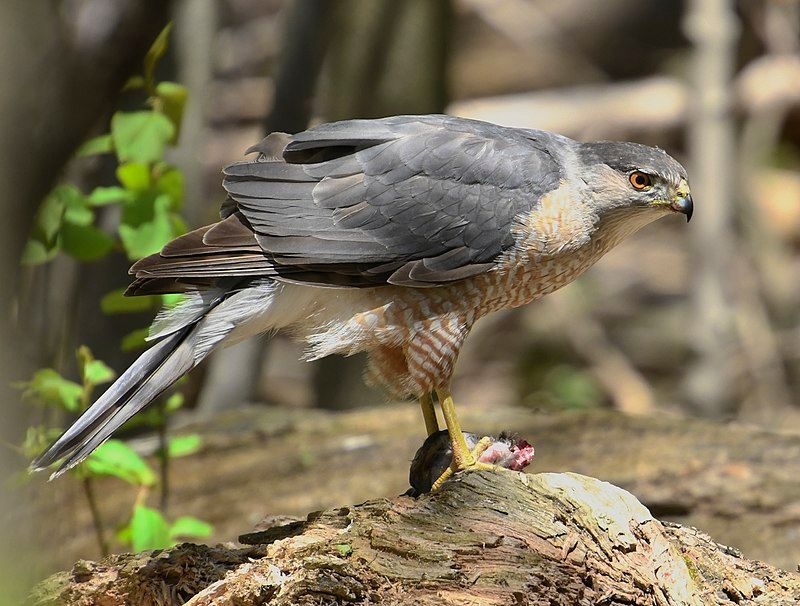
The Cooper’s hawk is a type of habe found in North America. It is considered to be a medium-sized bird.
This species is native to the continent and commonly found in regions ranging from southern Canada to Mexico. One attractive characteristic of the Cooper’s hawk is its size.
It falls into the category of medium-sized hawks, which means it is neither too big nor too small. This size allows the hawk to adapt and survive in different habitats across North America. The distribution of the Cooper’s hawk is quite extensive.
It can be found in North America, including southern Canada, the United States, and Mexico.
This wide range of habitats gives the hawk ample opportunities to thrive and establish its presence in various ecosystems. Despite its widespread distribution, the Cooper’s hawk is not evenly distributed throughout its range.
It tends to be more common in certain areas and less abundant in others. This variation in population density might be influenced by factors such as the availability of prey, nesting sites, and overall habitat suitability. The Cooper’s hawk is known for its hunting skills.
It primarily feeds on small to medium-sized birds, which it catches by surpriwithits speed and agility. This hawk is well-adapted.
| Kingdom | Animalia |
| Phylum | Chordata |
| Clade | Dinosauria |
| Class | Aves |
| Order | Accipitriformes |
| Family | Accipitridae |
| Genus | Accipiter |
| Species | A. cooperii |
46. Turkey Vulture
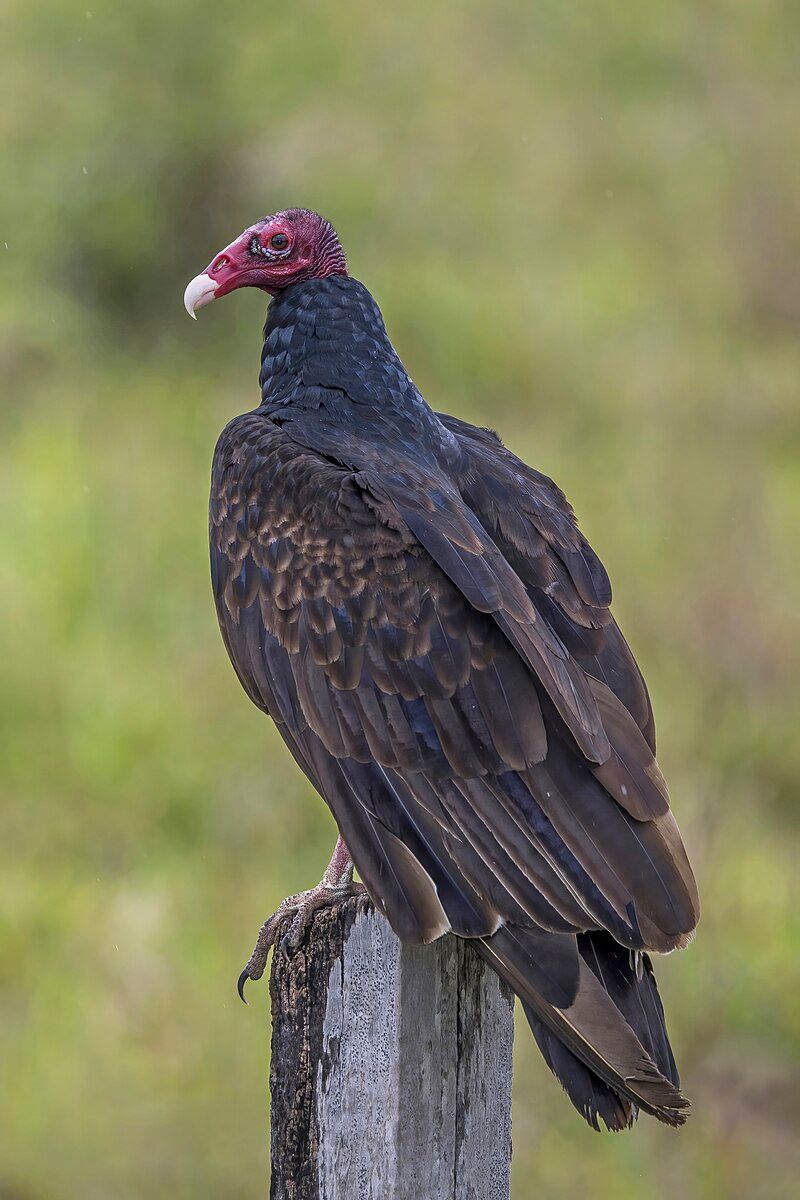
The turkey vulture is a type of vulture found in many parts of the Americas. It is the most widespread of all the New World vultures. There are three species of vultures in a group called the genus Cathartes.
The turkey vulture is one of these species. It belongs to the family Cathartidaa bird groups that include vultures. The turkey vulture can be found in a vast range of locations.
It can be seen from southern Canday down to the tip of South America. This message can be found in many countries and environments throughout the Americas. This bird has an extensive range because it is well-adapted to various habitats.
It can thrive in a wide range of conditions and climates. The turkey vulture is known for its characteristic appearance. It has a bald head, which is lor. Its body is black or dark brown, with long wings and a long tail.
This vulture is a scavenge machine that feeds on dead animals. It has a highly developed sense of smell, which allows it to locate carrion from high.
| Kingdom | Animalia |
| Phylum | Chordata |
| Clade | Dinosauria |
| Class | Aves |
| Order | Accipitriformes |
| Family | Cathartidae |
| Genus | Cathartes |
| Species | C. aura |
47. Laughing Gull
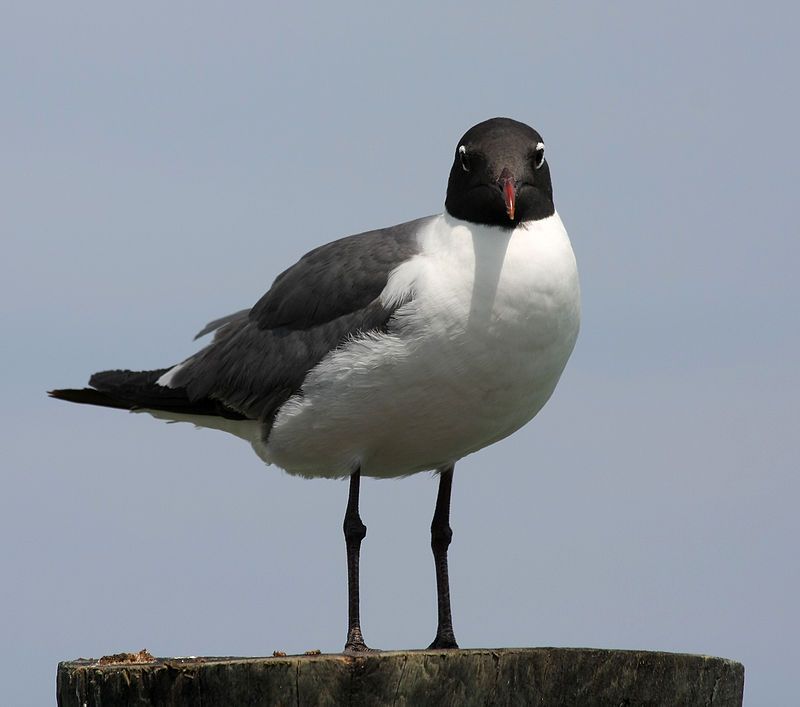
The laughing gull is a type of gull found in North and South America. It is called the laughing gull because of its distinctive laugh-like call.
This gull is a medium-sized bibe found in various habitats, including coastal areas and islands. The laughing gull is an opportunistic omnivore, which means it eats a wide range of food. It is known to scavenge for food, taking advantage of whatever is available.
This adaptability allows the laughing gull to survive in different environments and find sustenance even in challenging conditions. During the breeding season, the laughing gull forms large colonies along the Atlantic coast of North America, the Caribbean, and northern South America.
These colonies provide a safe and communal environment for nesting and raising their young.
Nesting in colonies also offers protection against predators and increases the chances of successful reproduction. The laughing gull has two recognized subspecies. Still, the paragraph does not provide information about their specific names or characteristics.
It would be interesting to learn more about the differences between these subspecies and how they adapt to their respective habitats. The laughing gull is a fascinating bias adapted well to its surroundings. Its ability to thrive in different environments.
| Kingdom | Animalia |
| Phylum | Chordata |
| Clade | Dinosauria |
| Class | Aves |
| Order | Charadriiformes |
| Family | Laridae |
| Genus | Leucophaeus |
| Species | L. atricilla |
48. Wild Turkey
The wild turkey is a type of bibe found in North America. It is considered an upland game bird because it lives in the upland areas of the continent.
The wild turkey is one of two species that still exist today. Belonging to the order Galliformes, the wild turkey is the heaviest member of this group. This means that the wild turkey weighs the most among all the birds in the Galliformes roost.
It has a large and robust body, which contributes to its heavy weight. Interestingly, the wild turkey is also the ancestor of the domestic turkey we commonly see today. The domestic turkey originated from wild turkey subspeciesved in southern Mexico.
Over time, humans selectively bred and domesticated these wild turkeys, resulting in the domesticated turkeys we now encounter. This means that the domestic turkey we often consume during special occasions or holidays, such as Thanksgiving, has its roots in the wild turkey.
Through selective breeding and domestication, humans have transformed the wild turkey into a biis suitable for farming and consumption. The wild turkey is a fascinating bird that has played a significant role in developing the domestic turkey.
| Kingdom | Animalia |
| Phylum | Chordata |
| Clade | Dinosauria |
| Class | Aves |
| Order | Galliformes |
| Family | Phasianidae |
| Genus | Meleagris |
| Species | M. gallopavo |
49. Savannah Sparrow
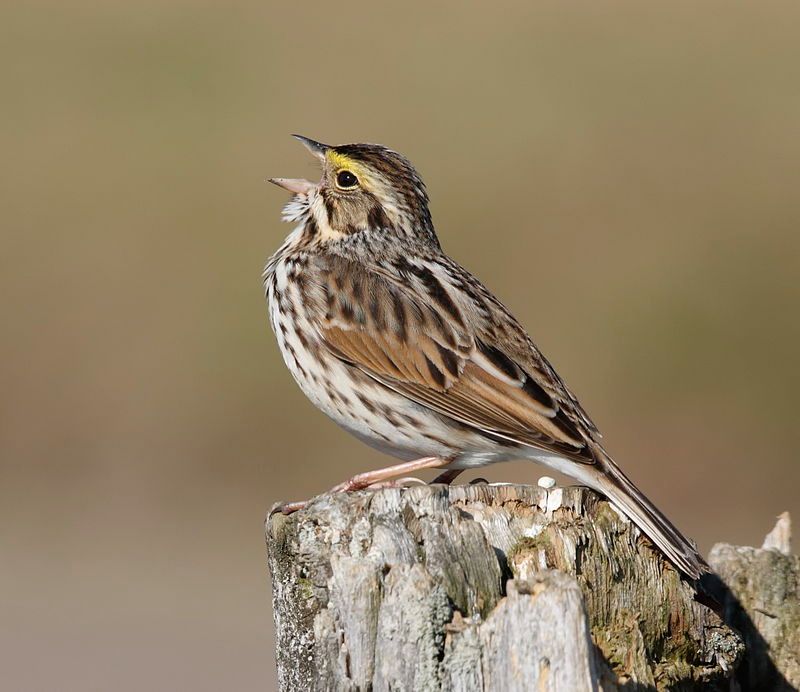
The Savannah sparrow is a small bird found in the New World. It belongs to the sparrow family and is known for its distinct features. In the past, it was the only species within the Passerculus genus.
However, over time, further research and studies have led to a change in this classification. Currently, the Savannah sparrow is still recognized as a distinct species. It is widely accepted as a member of the Passerculus genus.
This meant sharing common characteristics and traits with other species within this group.
However, it is essential to note that this genus is the only one that is widely accepted. Specifying species is a complex process that involves careful examination and analysis.
Scientists study physical characteristics, behavior, and genetic information to determine the relationships between organisms.
As more information becomes available, the understanding of species and their classifications can change. In the case of the Savannah sparrow, further research might have revealed new details on its genetic makeup or behavior.
This could have led to a reevaluation of its classification within the Passerculus genus. Other special previously considered members of this group might have been found to differ significantly, resulting in their exclusion from the genus.
| Kingdom | Animalia |
| Phylum | Chordata |
| Clade | Dinosauria |
| Class | Aves |
| Order | Passeriformes |
| Family | Passerellidae |
| Genus | Passerculus |
| Species | P. sandwichensis |
50. Magnolia Warbler
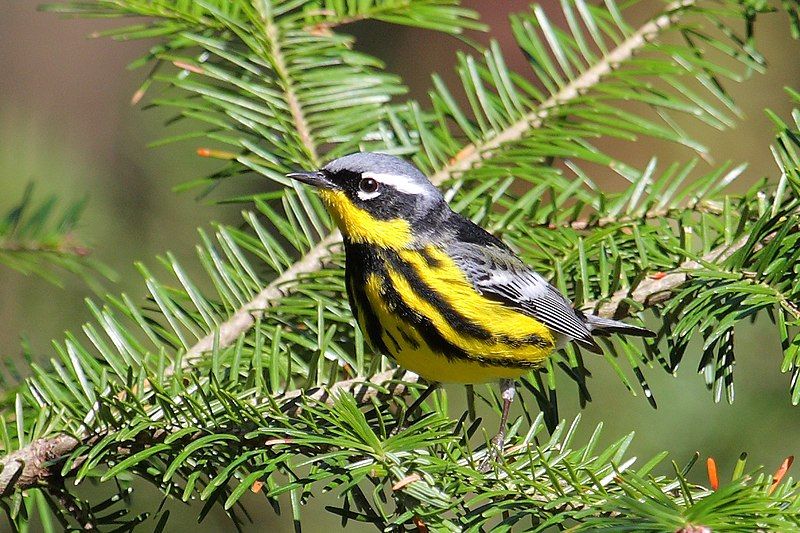
The magnolia warbler is a type of bird that belongs to the wood warbler family known as Parulidae.
The wood warbler family is a group of small, migratory songbirds commonly found in North America. Another member of its family, the magnolia warbler y, is known for its beautiful and melodic song.
It has a unique and distinctive coat that helps birdwatchers identify it in the wild. This species gets its name from its preference for nesting and foraging in magnolia trees.
However, it is essential to note that the magnolia warbler is not limited to magnolia trees and can also be found in various other forested habitats. The magnolia warbler is a migratory bird that travels long distances yearly to breed and find food.
During the breeding season, it can be found in the boreal forests of Canada and the northeastern United States during the breeding seasons. In the winter, it migrates to Central America and the Caribbean. These birds are relatively small, measuring about 4.5 to 5 inches long.
They have a yellow chest and belly, with black streaks on their sides and back. The males and females have similar plumage, making it.
| Kingdom | Animalia |
| Phylum | Chordata |
| Clade | Dinosauria |
| Class | Aves |
| Order | Passeriformes |
| Family | Parulidae |
| Genus | Setophaga |
| Species | S. magnolia |
51. Ross’s Goose
Ross’s goose is a type of goose that is predominantly whole. It has a black wingtip, meaning the ends of its wings are black. Compared to other geese, Ross’s goose has a relatively short neck.
Ross’s goose is the smallest among the whigooseese species that breed in North America. This meant it was more minor than other types of white geese in the region. Visually, Ross’s goose bears a resemblance to a white-phase snow goose.
However, there is a noticeable difference in their sizes. Ross’s goose is about 40% smaller than a white-phase snow goose. To summarize, Ross’s goose is characterized by its white color, black wingtips, and shorter neck.
It is the smallest among the three white goose species found in North America and is similar in appearance to a white-phase snow goose but smaller in size.
| Kingdom | Animalia |
| Phylum | Chordata |
| Clade | Dinosauria |
| Class | Aves |
| Order | Anseriformes |
| Family | Anatidae |
| Genus | Anser |
| Species | A. rossii |
Conclusion
Winter birds in Alabama bring a vibrant and diverse array of species to the state during the colder months. These remarkable bircan endure the harsh conditions and find solace in the abundant food sources available.
From the majestic Bald Eagle to the adorable Dark-eyed Junco, each species contributes to the rich ecological tapestry of Alabama.
The presence of winter birds not only brings joy to birdwatchers and nature enthusiasts but also serves as a reminder of the resilience and adaptability of nature.
As we continue to protect and preserve the natural habitat these birds rely on, we can ensure that future generations will have the opportunity to witness the beauty and wonder of winter birds in Alabama.